 Ten ships (DDG 37 – DDG 46) 1957-93:
Ten ships (DDG 37 – DDG 46) 1957-93:
USS Farragut, Luce, MacDonough, Coontz, King, Mahan, Dahlgren, William. D. Pratt, Dewey, Preble
Cold War US DDs:
Fletcher DDE class | Gearing DDE class | Gearing FRAM I class | Sumner FRAM II class | Forrest Sherman class | Mitscher class | Farragut class | Norfolk class | Charles F. Adams class | Spruance class | Arleigh Burke class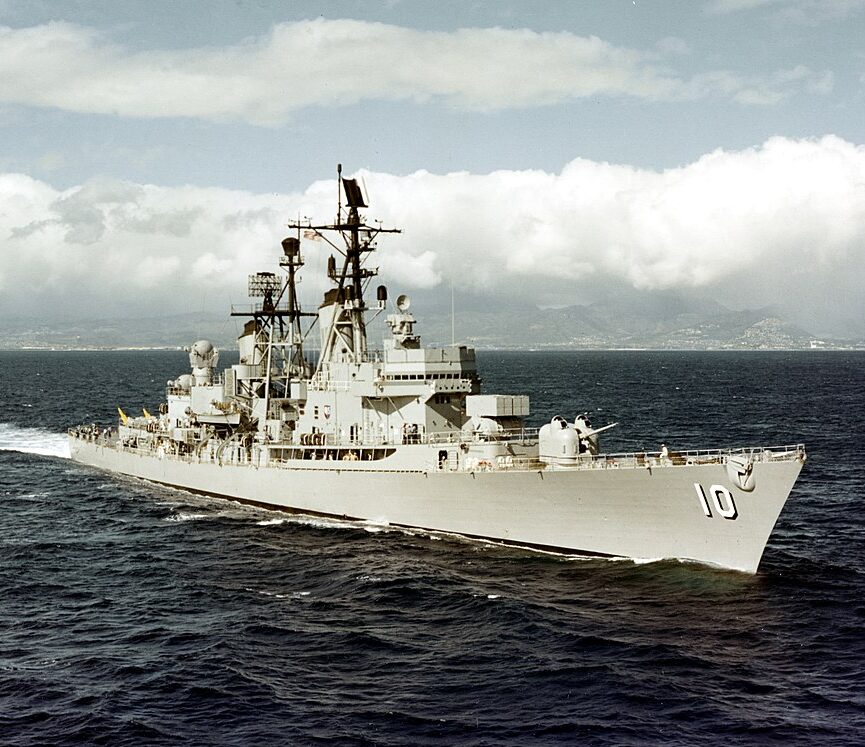
USS King off Oahu in September 1961, freshly commissioned.
The Farragut-class were the first were ten USN guided-missile destroyers in the 1950s, creating a brand new branch in the US fleet classification. Second destroyer class named after Admiral David Farragut they were also sometimes called the “Coontz class” as first unit designed and built under project SCB 142. Indeed the other ships of the class were laid down as follows-up of the Forrest Sherman class under SCB 129 and later converted as DDG. They were also referred as Frigates, destroyer leaders or DL/DL but reclassified as Guided-Missile Destroyers after the 1975 reclassification.
Apart one exeption their active career started in 1960 and they saw the entire cold war up to its conclusion in 1991, seeing extensive combat service in Vietnam and Mediterranean.
They were followed by the Charles F. Adams and seconded by the Leahy class Destroyer leaders/Missile Cruisers.
Design Development
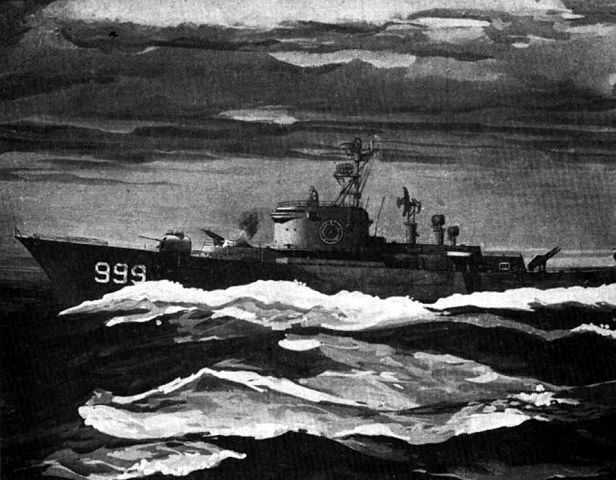
Artist’s Impression of the Farragut class in 1958
FY 58 ships and the Schindler Committee proposals
The Farragut class guided missile “destroyers” were constructed in the late 1950s and early 1960s.
The initial project saw the first three originally armed only with guns. They were indeed designed on the recommendation of the Schindler Committee on the “Long Range Shipbuilding Plan” (1954). This committee argued for the construction of specialized Fast Task Force Escorts mostly tailored for anti-aircraft screening. Sill, they were given good submarine detection, but no ways to sink them, which was the task of dedicated, smaller escorts.
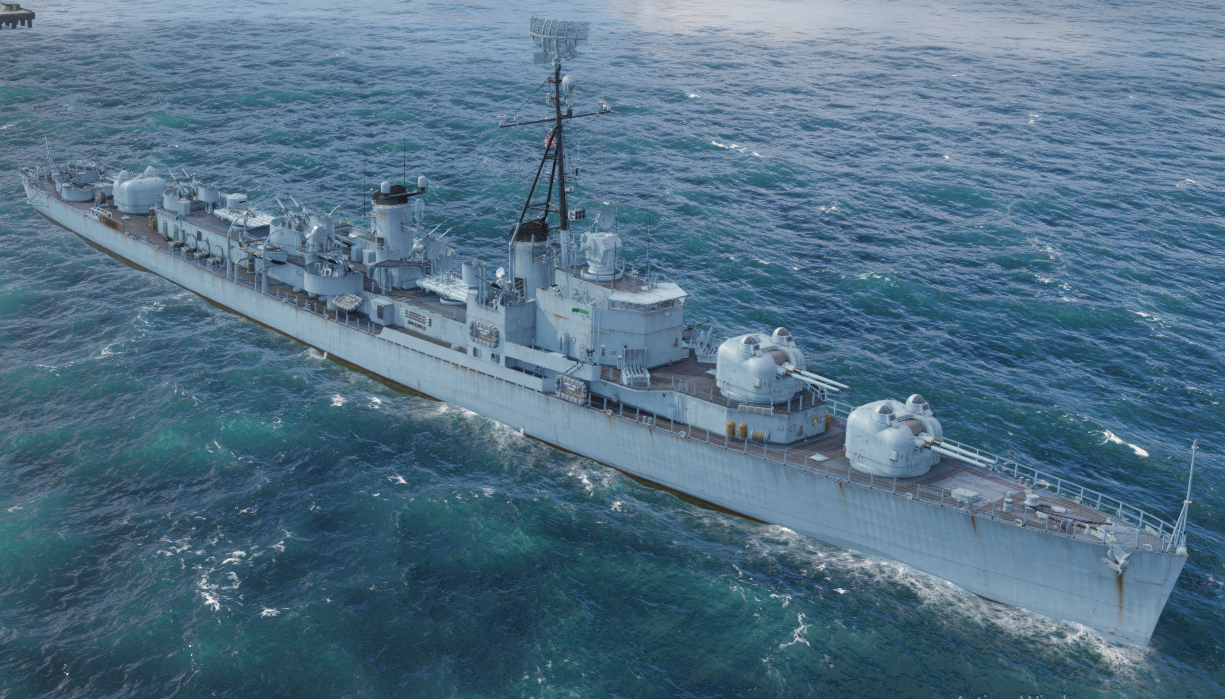
“USS Joshua Humphrey” a 1950 Project reminiscent of the early SCB 129 gun armed destroyers (World of Warships rendition), presented as “an evolution of the Gearing class”
The resulting design was an enlarged Forrest Sherman type with four of the new single rapid-fire 5-in/54s and two twin 76mm/50s. ASW weaponry only comprised a single depth-charge track aft and two fixed Hedgehogs forward plus a quintuple torpedo tube bank. A survivance of WW2 concepts it was there to primarily “embarrass enemy heavy units attempting to attack the carrier task force” as digested from the battle of Samar in October 1944.
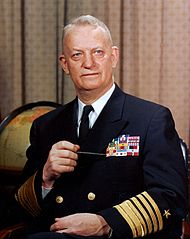 However, throughout the design, installation of Terrier missiles (in development since 1950 for an entry into service in 1953-54) in place of the two after 127mm/54s was looked after as an alternative. Eventually in 1955 the Chief of Naval Operations (CNO) Admiral Carney, decided that half of the new planned FY56 ships were to be built as missile frigates. Admiral Burke which succeeded him decided to futher and have all six FY56 vessels converted back as missiles-carrier escorts ships as missile ships.
However, throughout the design, installation of Terrier missiles (in development since 1950 for an entry into service in 1953-54) in place of the two after 127mm/54s was looked after as an alternative. Eventually in 1955 the Chief of Naval Operations (CNO) Admiral Carney, decided that half of the new planned FY56 ships were to be built as missile frigates. Admiral Burke which succeeded him decided to futher and have all six FY56 vessels converted back as missiles-carrier escorts ships as missile ships.
The planned development of new anti-surface ship torpedoes for this class was also abandoned and the planned quintuple bank which was not studied to operate the new long-range anti-submarine torpedoes of the Makr 32 types, were also cancelled and retired from the design.
Meanwhile, some raised the issue of new, fast Soviet nuclear submarines, which threatened Fast Task Forces and compromised the defence provided by the fast fleet escorts. A new redesign followed, at first with rocket-assisted torpedo (RAT) and then ASROC as it was also planned to be introduced. Hence the cancellation of the two forward 127mm/54s, while the sonar was upgraded from the SQS-4 to the far better SQS-23 standard (see below).
A designation headache
Designation became soon a headache. Not only they were also frequently called the Coontz class (DDG 40 Coontz was the first designed and built in the class) and previous ships classified at first as “hunter killer destroyers” (DK), converted on the stocks for the new Terrier SAM and at the same time known as “fleet escorts”, they were significantly larger than previous destroyers; So much so, the Navy resurrected the term “frigate” understood as an in-between a cruiser and destroyer. Another early classification was “Destroyer Leader” [DL] was dropped for “Guided Missile Frigate” [DLG] in 1956 as they were completed. Then came the 1975 reclassification as “Guided Missile Destroyer” [DDG] with completely new hull numbers.
Of the six ships initially ordered at the same time, the first triplet, USS Farragut, Luce and Macdonough, were numbered after the Mitscher class as DL 6–8 (all gun destroyers) while Coontz, King and Mahan became DLG 1–3 as they mixed a gun and missiles. Both groups were for the admiralty intended to be fast task force air defense, hence the “fleet escort” denomination. A decision was made later (date unknown) to build all six to the Coontz (DLG) standard and renumber them as DLGs 6–11 and including four more, for a ten-ship order, distributed through five shipyards, on 14 November 1956, just three weeks before USS Gyatt became the first USN guided missile destroyer. There is some resemblance in the story of the Gyatt/Livermore with a Navy tradition dictating that a class of like ships take the name of the low-numbered hull; In that case, the Coontz class and later confusingly the “Farragut-Coontz” in part oto differentiate them from the original “gold platters”, the 1930s Farraguts. In most publications today, “Farragut” however is the correct standard, and often “missile frigate” added to further differenciate them.
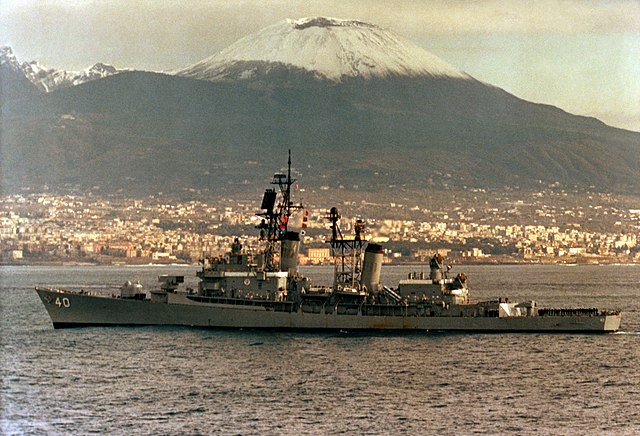
USS Coontz off Naples in June 1980
The ten ships commissioned in 1959–61 emerged first from Bath Iron Works (Dewey and Preble) and the whole class soon find the same roles as the later Charles F. Adams-class. All were comprehensively over twenty years and until 1982. However USS Mahan was the only one to receive the “New Threat Upgrade” (NTU) package. They were pushed to the sortie by the new 1990s Arleigh Burke-class, infinitely more advanced with a state of the art Aegis system. None was even sold abroad, as the systems onboard were already recoignised as obsolete.
The term “frigate” applied to them in 1975 was not facilitating classifications. The range of “Frigates” indeed in the 1975 went from USS Long Beach, originally also classed as such (but later as cruiser) ans much smaller escort ships that were the Bronstein/Garcia and Knox class. The final redesignation as guided missile destroyers (DDG) and renumeration made more sense.
Design of the class

USS Dewey in 1961, original design
Hull and general design
Overall these destroyers were the largest ever built -apart leaders such as USS Norfolk-being in length 512 feet 6 inches (156.2 m), 52 feet 4 inches (16.0 m) in beam (so around 1.2/10 ratio) and 17 feet 9 inches (5.4 m) deep draft. Displacement was 5,648 long tons standard and 5,739 t when fully loaded. To compare, Norfolk was 540 ft x 53 ft x 19 ft, displacing 4,956t, 5,556t FL Fully Loaded so even less.
As usual they used a flush-deck hull with a tall prow, and bulwarks alongside the forward superstructure that was as large as the beam, stopping incoming waves on the aft deck.
Armament repartition was the following: Forward unique main gun, with a well cleared arc, ASROC on the superstructure, same, two ASW TTs on the superstrcuture roof either side between the two funnels, two 76mm AA on the upper bridge aft, and the Terrier missile launcher on deck aft. There was little room available for an helicopter pad, and nothing was planned to house or operate one anyway, although some landed on their deck during their career, in Vietnam notably.
The ships were caracterized by tall superstructures in order to have extra room for flagship use, since it was also planned to used them as destroyer leaders originally. So much so in fact they appeared in service top-heavy and limited their upgrade capabilities on the long run. Thus, the towering bridge and followed by a solid tripod, two tall raked funnels for better exhaust draft, a rather tall aft bridge to support the two fire control radars and a mainmast which was for the first time a solid four-legged derrick, able to carry heavier radar systems on the long run. During their upgrades, the latter proved handy, while the tripod foremast was swapped for another four-legged derrick. The added weight of new radars did not improved their overweight issues.
The crew amounted to 23 officers and 337 ratings, which was reasonable given the size of these ships. Theese ships had two cutters on davits amidships, and standard inflatable rafts in containers on either sides.
Powerplant
Nothing revolutionary here. It was the most conservative aspect of the ships, a very conventional steam powerplant: The ships were equipped with two propeller shafts, driven by geared steam turbines (either Allis-Chalmers or De Laval). Steam came from four Babcock & Wilcox or Foster-Wheeler D-Type, superheated water-tube boilers rated for 1,200-pound in forced-draft, for a total of 85,000 shaft horsepower (63,000 kW). Their designed speed was 32 knots (59 km/h; 37 mph). Range was 5,000 nautical miles (9,300 km; 5,800 mi) at 20 knots (37 km/h; 23 mph) based on a normal oil storage of 900 tons.
DLG-6-8 had two sets of De Laval geared steam turbines and Foster Wheeler boilers, DLG-9-14 Allis Chalmers turbines and Babcock & Wilcox boilers and DLG-15 De Laval turbines and Babcock & Wilcox boilers.
Armament
Main Gun
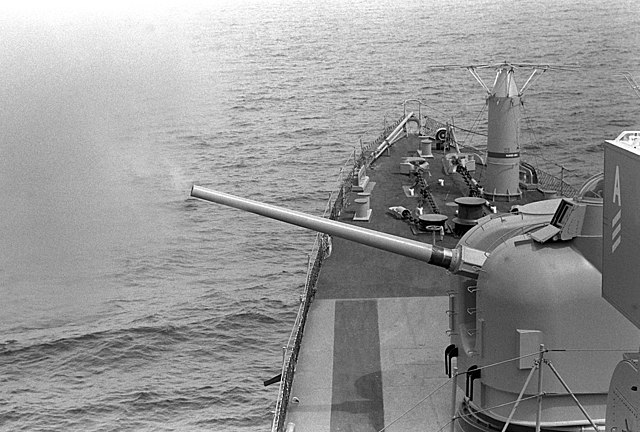
5-in/50 firing from USS Dewey in 1979
The Farragut-class ships were armed with a 5″/54 caliber Mark 42 gun forward. The same type multiplied by three on the previous Forrest Sherman, and which ade the legendary twin 5-in/38 redundant. It is coupled with the AN/SPG-53 gun fire control RADAR. In short: 40 rpm, mv 2,650 ft/s (807.7 m/s) range 25,909 yd (23,691.2 m), Ceiling 51,600 ft (15,727.7 m). The ideal dual-purpose weapon. In Vietnam it was used for coastal bombardment with accuracy.
3-inches/50 Mk.22 AA Guns
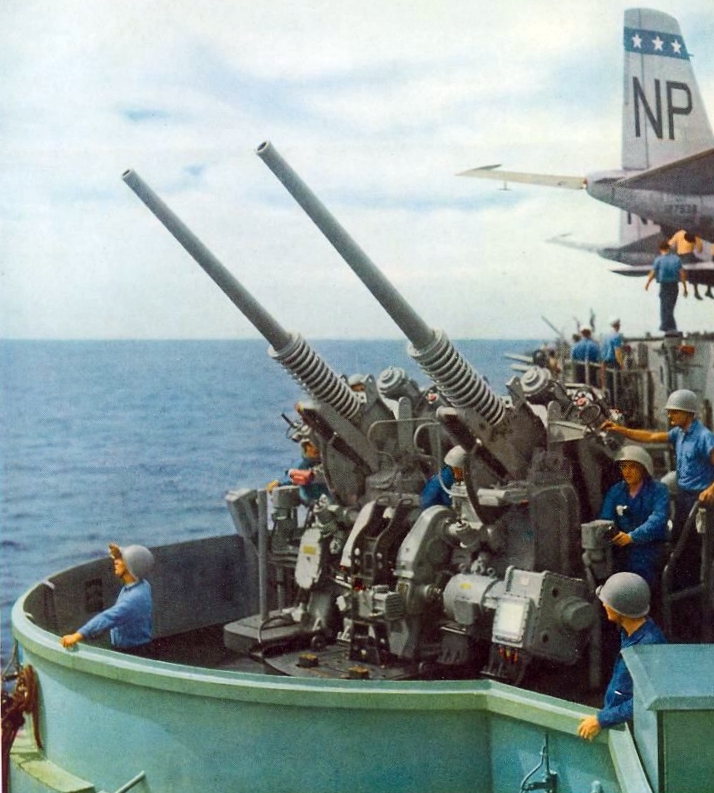
An inheritance of past designs, they were a guarantee past the long range bubble offered by the Terrier SAM. They were located on either side on sponsons just at the rear of the aft funnel.
Short specs: ROF 28 rpm at 2,700 fps (823 mps) 14,600 yards (13,350 m) range and 30,400 feet (9,266 m) ceiling.
They were removed in the 1970s and never replaced, although tests were performed with CIWS on two ships in the 1980s.
Terrier SAM
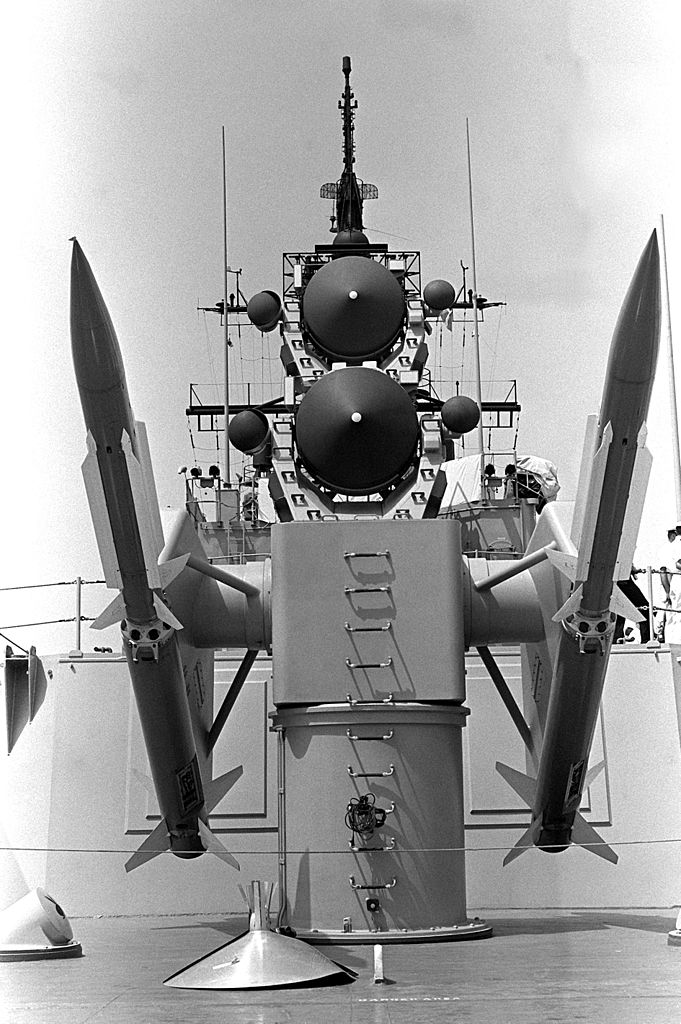
Mark 10 missile launcher on USS Dewey, 1979
The real novelty of the design. This standard SAM, part of the “three T” (Talos, Terrier, Tartar) was the early missile system developed for the USN. It was studied in the late 1950s and operational in 1956. When the Farraguts were completed, it was already well-rounded, with the Mach 3 Terrier BT-3 (Beam-riding, Tail control, series 3) introduced in 1958 and in 1962, the even more nasty The RIM-2D Terrier BT-3A(N) which entered service in 1962 with a W30 1kt nuclear warhead. It seems only cruisers carried that kind of warhead. The standard was the 218 lb (99 kg) controlled-fragmentation warhead.
Specs in short: 3,000 lb (1,400 kg) for 27 ft x13.5 in (8.2 x 0.34 m), solid fuel rocket engine for Mach 2-3 (depending on versions), range 17.3 nmi (32.0 km), ceiling 80,000 ft (24,000 m), using Semi-active radar homing. It was coupled with the AN/SPG-55 radar system. In the late 1970 and early 1980s it was replaced by the far more efficient SM-1 Standard.
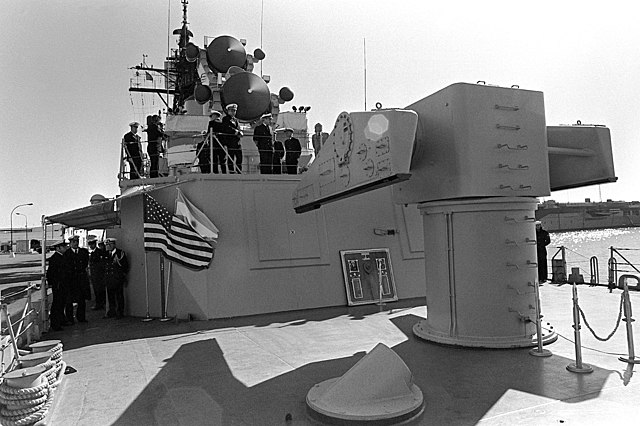

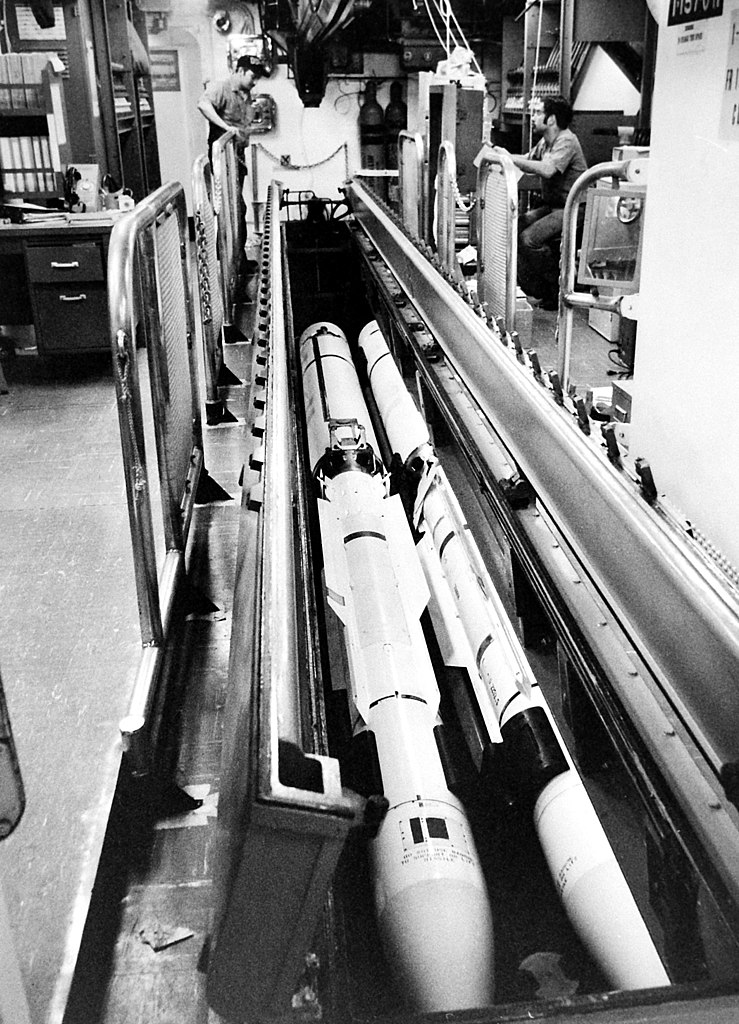
RIM 67 Terrier with the internal reloading system
ASW: RUR-5 ASROC
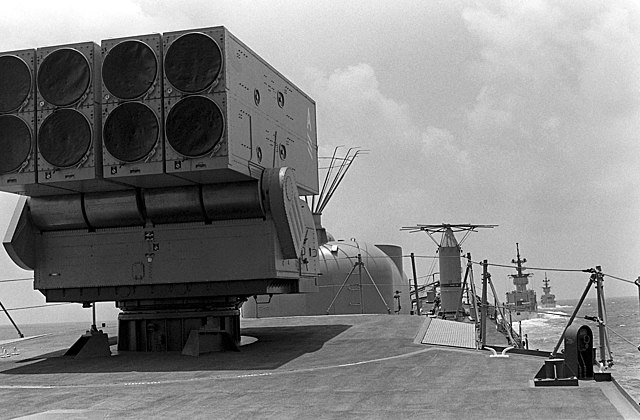
ASROC on USS Dewey in 1979
They were fitted with an eight-round ASROC launcher between the 5-inch (127 mm) gun and the bridge. USS Farragut (DDG-37) however was the only one with her ASROC magazine mounted behind the launcher. The class was notoriously top-heavy and this atop magazine made it worse made it worse so tha this experiment was stopped and all further nine were completed with magazines relocated down. The system was introduced in 1961, just as the class was completed. It was the go-to missile ASW system in service up to this day. The octuple launcher can be reloaded twice.
ASW: TTs

The 324 mm Mark 32 Surface Vessel Torpedo Tubes are ASW triple torpedo launchers installed forward amidship on the upper deck. Developed in the early 1960 they were installed at completion.
The entire launcher weights 2,230 lb (1,010 kg) in fiberglass-metal, enabling an installation practically anywhere, added to its compact size. It was able to fire at first the 12.75-inch (324 mm) Mark 44. In later upgrades the Mark 46, 50 or 54 could be fitted. The Mark 44 is the “universal” cold war acoustic ASW torpedo. It was designed to be airbone as well as shipborne. Weighting 432 pounds (196 kg) for just 8.2 feet (2.5 m) and a diameter of 12.75 inches (32.4 cm) it had a 123 metres per second (400 ft/s) initial velocity, with electric drive 30 hp (22 kW) up to 30 knots (56 km/h; 35 mph).
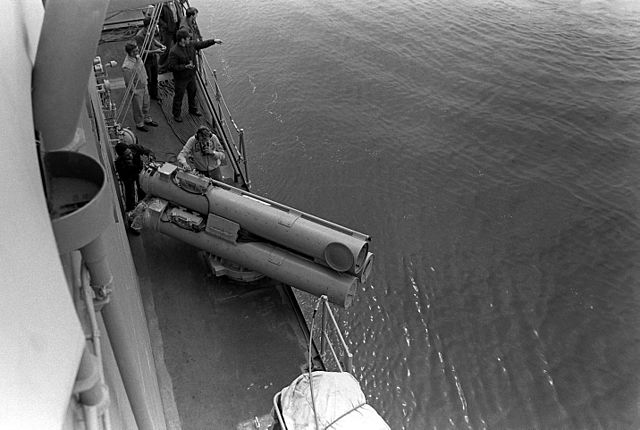
The torpedo launcher is trained on USS Dewey in 1979.
The Mark 44 carries a Mk 101 Mod 0, HBX-3 75 pounds (34 kg) warhead with a Mk 19 type Mod 12 contact exploder. It is an active guidance model using Helix search from 123 metres (135 yd) to 3.4 miles (5.5 km) and down to 1,000 yards (910 m) mas depth.
Sensors
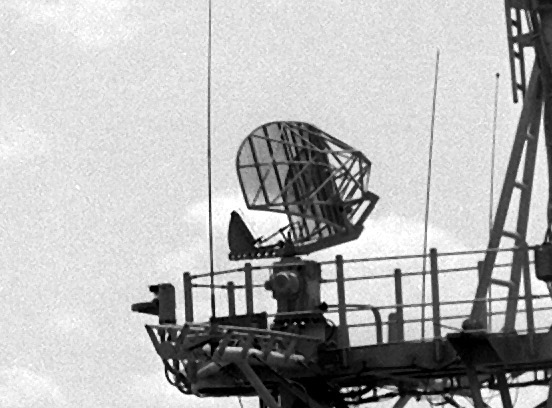
One AN/SPS-10 surface search RADAR (1959): 2D 280 KW radar from Raytheon working on C Band PRF 650 Hz, BmWt 1.9°×16°, Pwdt 1.3 µs
One AN/SPS-48 3D air search RADAR (1965): 3D 35 KW Air-search Frq E-F band Range 250 nmi (460 km) 100,000 ft (30,000 m), prec. 690 ft (210 m)
One AN/SPG-53 gun fire control RADAR (1955): FCS 5-in. 250kW. Range 120,000 yd (59 nmi)
Two AN/SPG-55 Terrier FCRs: 3D, Supporting Beam-riding and homing Terrier missiles, controlled by a UNIVAC 1218 computer.
One AN/SQS-23 SONAR (1958): Used for the Mk.32 TTs. 5 kHz 20 ft, 10,000 yds range, search, search-analyze, attack-RDT, attack-SDT modes, using the Ship center display and TCD for attack.
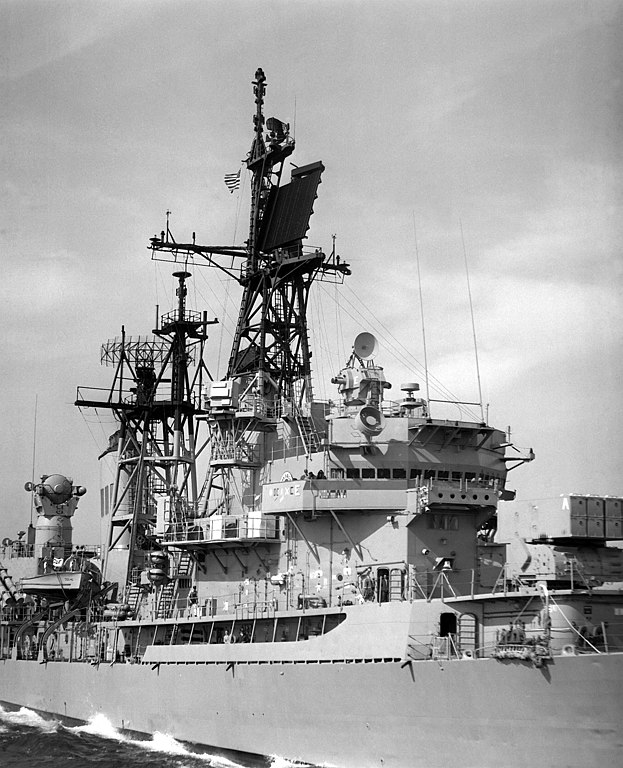
Superstructure radars on USS Coontz
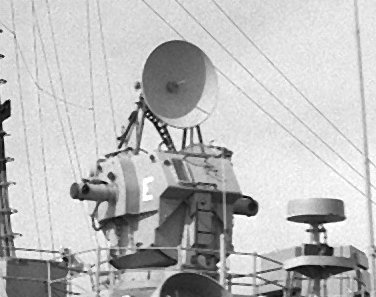
Mark 68 director and SPG-53
DLG6, 14, 15 had the following SPS-53, SPS-10B, SPS-29, SPS-37, and two SPQ-5, SPG-53A, and two Mk 35 radars plus the SQS-23 sonar and after refits, the WLR-1, WLR-11 and ULQ-6B ECM suites.
DLG7-13 only diverged by having two SPG-55A Fire Control Radars.
After refit:
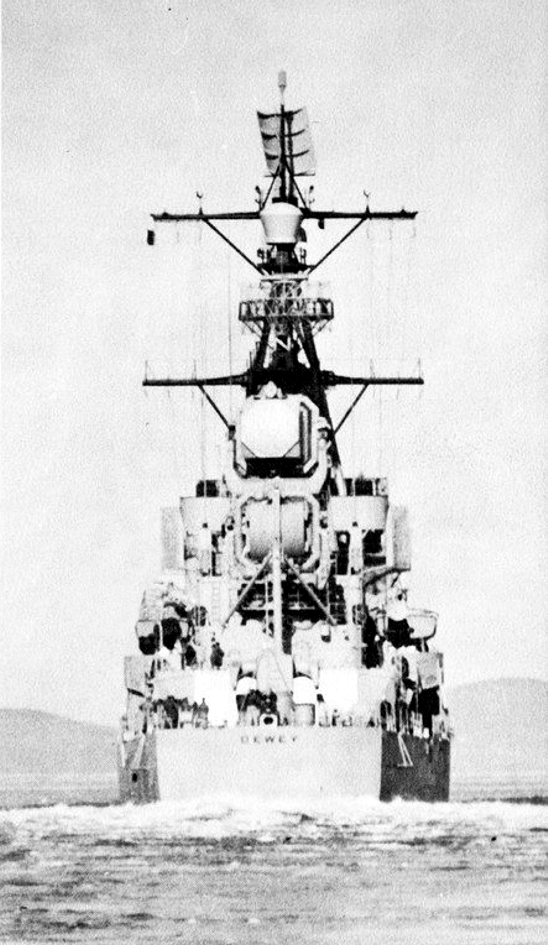
Stern view of USS Dewey in late 1959
One AN/SPS-49 air search RADAR (1975+): 2D Air-search 360 kW working on L band 851–942 MHz Range 256 nmi (474 km), 150,000 ft (45,720 m) prec. 1/16 nmi range
AN/SLQ-32(v)3 Electronic Warfare System (1980s): Added antennas with electronic attack capability, jammaing targeting radars and terminal guidance radars.
Mark 36 SRBOC Decoy Launching System: Automatic Chaff launcher, interfaced with the AN/SLQ-32 suite.
Until 1977 the installation of the SM-1 Standard was accompanied by the installation of the SPS-48C, SPS-49, and two SPG-55B fire control radars plus the NTDS CCS.
USS King in 1973-1974 was the only one in the class to test CIWS and the associated Mk 90 radars for tests. In the 1980s, SQQ-23A PAIR sonar was installed for all ships, and the SLQ-32(v)2 ECM suite, plus Mk 36 SRBOC decoy chaff launchers. USS Mahan was a particular case, the only one fitted with the Block II SAM and associated SPS-48E, SPS-49(v)5 radars and a new electroinc warfare suite, with the SYS-2 IADT CCS, and NTU package (New Threat Upgrade).
Onboard Helicopters
![]()
Kaman UH-2 Seasprite aboard USS Coontz (DLG-9) on July 1969
In 1956-57, the Farragut class did not planned to have an onboard helicopter. The semi-transom stern allowed a small spot, encumbered with many structural elements. However due to the suefulness of Helicopters in Vietnam it was decided to convert USS Coontz first as an experiment. In December 1965 while San Diego for her overhaul, completed in January 1966 she was given a proper Helicopter Landing/Handling pad. This capability implied the relocated of all deck vents fantail and deck obstructions plus a JP-5 fuel tank installed under the deck, and handling/purification system, as well as an electric “plug” connection, to start or power an helicopter. It was even possible to reful and helicopter while flying over the ship. USS Coontz was the first to receive that upgrade which implied a reinforced deck with a painted spot to operate medium and large helicopters (up to the size of a Chinook), deploying some for short periods notably as missile data link platforms, ASW and SAR operations but also liaison in Vietnam.
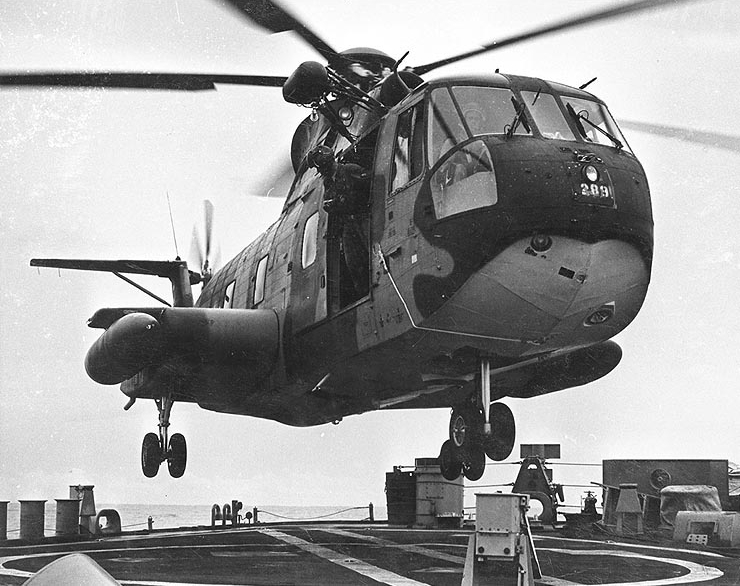
CH-3E hovers over USS William V. Pratt off Vietnam in 1967

Chinook over USS Pratt in Vietnam.
Construction
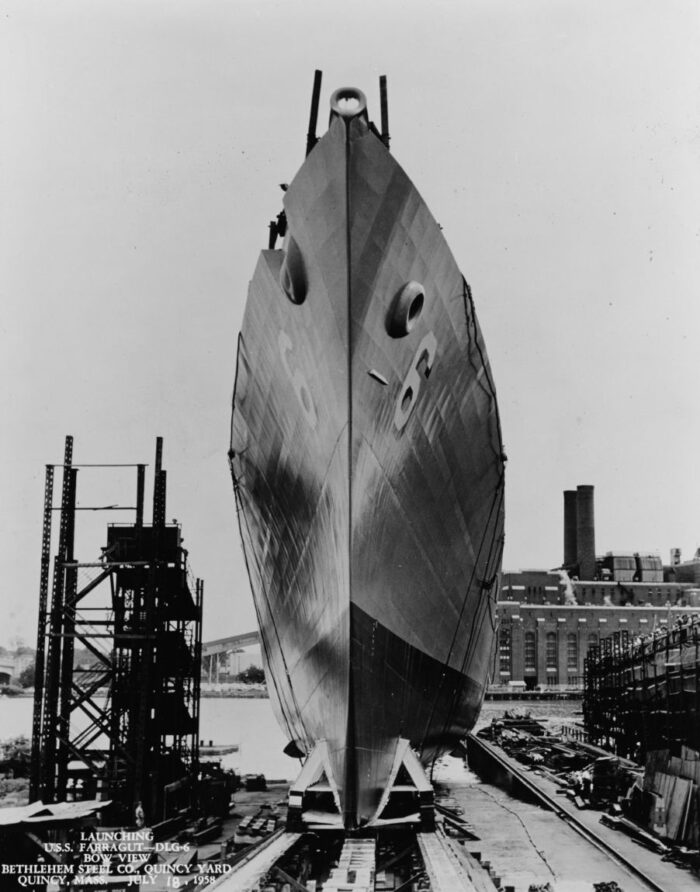
Launch of USS Farragut, July 1958
The ten ships were ordered in two batches, the first three at Bethlehem Steel Corporation, Fore River Shipyard (Farragut, Luce, McDonough), Puget Sound Naval Shipyard (Coontz, King), San Francisco Naval Shipyard (Mahan), and another from DDG-43 at Philadelphia Naval Shipyard (Dahlgren, Pratt) and Bath Iron Works (Dewey, Preble). Construction time was about four years, much longer than for an average destroyer, but due in part to the late DDG conversion and redesigns. USS Farragut was laid down on 3 June 1957, launched a year later on 18 July 1958 and completed two years later on 10 December 1960. Teething problems and redesigns meant the completion time was halved on the laets ships, like USS Preble (DDG-46) launched on 23 May 1959 and completed less than a year later on 9 May 1960.
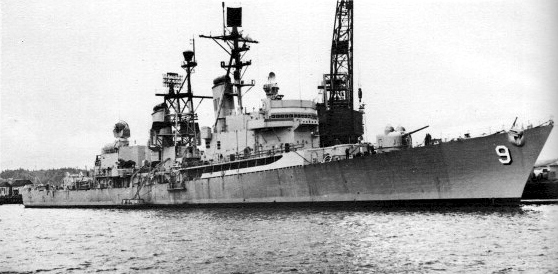
USS Coontz fitting out at Puget Sound in 1959
⚙ specifications |
|
| Displacement | 4,167 lt standard, 5,648 lt deep load |
| Dimensions | 512 ft 6 in x 52 ft 4 in x 17 ft 9 in (156.2 x 16 x 5.4 m) |
| Propulsion | 2 shafts GS turbines, 4 WT FD B&W SH Boilers 85,000 shp (63,000 kW) |
| Speed | 32 knots (59 km/h; 37 mph) as designed |
| Range | 5,000 nautical miles (9,300 km; 5,800 mi) at 20 knots |
| Armament | 1×2 Mk10 Terrier SAM, 5-in/54 gun, ASROC, 2×3 Mk 32 TTs, see notes. |
| Sensors | AN/SPS-10, 48, 49, 53 Gun FCR, 2x AN/SPG-55 Missile FCR, AN/SQS-23 SONAR |
| Crew | 23 officers, 337 enlisted men |
Upgrades and Assessment
Upgrades of the class
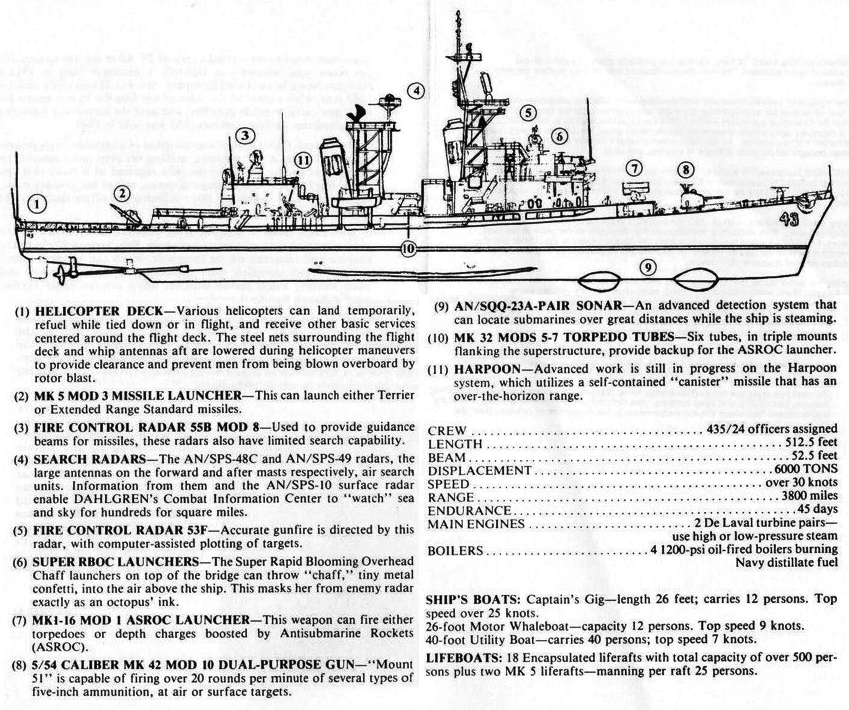
Their first upgrade was in 1970-1977, commmon to all ships when possible. They had their Terrier SAM replaced Standard SM-1ER SAM (40 RIM-66), the twin 76mm/50 eliminated. As for electronics, they gained two SPS-48C FC radars for the Standard SAM, the SPS-49, two SPG-55B radars and an NTDS CCS system. But there were individual cases: In 1970 USS Farragut had its original ASROC stowage replaced like her sister, and raised to 16 RUR-5 (two reloads). In 1973-1974 USS King received two 6-barreled 20mm/76 Mk 15 Phalanx, and two Mk 90 radars to perform testings. In 1973-1975 USS also received two CIWS, but for tests. In 1977-1979 USS Farragut, Coontz and Dahlgren were the first provided the new Harpoon SSM, in two quad canisters installed amidhips.
The 1980s saw a second wave of upgrades: The test of the class (USS Luce, Macdonough, King, Mahan, William V. Pratt, Dewey and Preble) received from 1980 to 1983 also two quad Harpoon SSM RGM-84 in turn.
Between 1982 and 1985, they receoved four additional Browning M5HB HMGs (12.7mm/90) and an updated electronics suite: SPS-48C and SPS-49 radars, the new SQQ-23A PAIR sonar and SLQ-32(v)2 ECM suite, as well as four Mk 36 SRBOC decoy RL. In 1983, only USS Mahan received the new Standard SM-2ER Block II SAM (40 RIM-67) and to go with it, two SPS-48E and SPS-49(v)5 radars as well as the new SYS-2 IADT CCS suite. She was the most modern of all the class before decommission.
Despite these periodic modernizations these ships were retired in the early 1990s although at some point it was planned to have them upgraded to the New Threat Upgrade (NTU) package. It was terminated as not cost effective given their limited planned service remaining. The 1989 Amended budget submission even accelerated their planned with only USS Mahan (DDG 42) as seen above receiving the NTU modernization in 1982, only for tests and was planned for retirement FY 93. They just could not compete with the Arleigh Burke (DDG 51) class.
As for numerations, DDG-25-DDG-30 were Charles Adams class ships and DDG-1, DDG-31-36 were converted Farraguts to be stricken 1978-1988.
General assessment of the Farragut class
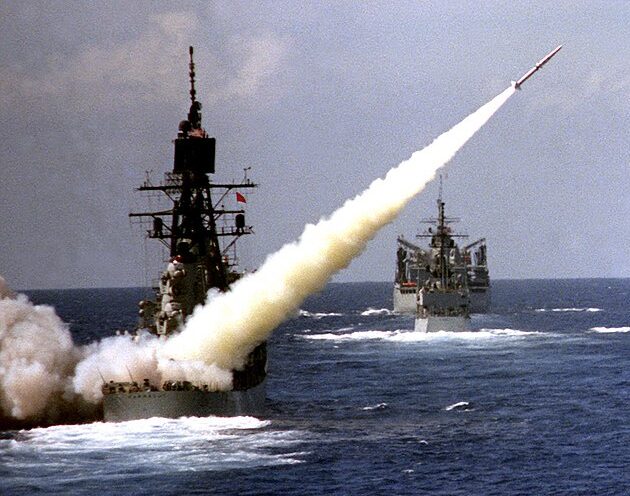
USS Farragut furing her RIM-2 Terrier, circa 1975
Originally commissioned as guided-missile frigates (DLG) and redesignated as guided-missile destroyers (DDG) in 1975 these were the only USN destroyers not to be only only redesignated but renumbered which added to the Coontz/Farragut mix in some sources. All subsequent vessels being renumbered upwards. Refits saw the addition of quad Harpoon anti-ship missile launchers, addition of new fire control and search radars as the Terrier was ceded for the SM-2 ER missiles to keep them relevant without impairing too much their already top-heavy confition.
Their extensive superstrctures were later seen indeed as a design shortcoming and this helped the next Charles F. Adams DDG class to be much improved: Their bridge for example was cut down to a full deck and many structures were curtailes and more compact. This never impaired their capabilities and they were seen as more successful, as well as being exported. They saw much more service as a result.
The decommission of the Farragut class between 1989 and 1994 was not really due to the lack of upgrade, as it was still possible to keep them relevant in 1990, but in the end of their planned replacement by the Arleigh Burke class and their new AEGIS standard was such an enormous gap in capacity. The last reason was thei absence of possible customer for them, probably not attracted by a 1950s hull with little capacity for upgrade and worn out machinery as well.
Career-wise, they proved their worth as flagships, but some developed machinery issues, just like the Forrest Shermans. This led to review many aspects of the powerplant and lessons were partly implemented on the next Charles F Adams, but more on the Spruance class.
Career of the Farragut class
 USS Farragut (DDG-37)
USS Farragut (DDG-37)

USS Farragut in the Atlantic, 2 July 1982
USS Farragut, third destroyer named after Admiral David Glasgow Farragut, became DLG-6 after being ordered at Bethlehem Steel Corp. in Quincy Massachusetts. Launched on 15 July 1958 she was commissioned on 10 December 1960 under command of Captain Greer.
After her shakedown training in the Caribbean she visited Haiti and Cuba and as back in Pensacola by June 1961 for post-shakedown fixes. She stopped in New Orleans and took part in the 250th anniversary of the founding of Mobile, Alabama. Based in Boston she was homeported at Mayport in July. She sortied in northern European waters on 20 November 1961, stopping at Portsmouth, Stockholm and Malmo, Copenhagen, Hamburg, and while back south, Lisbon, and joined the Sixth Fleet via Gibraltar in January–February 1962. She stopped in the Balearic Islands on her way back to Mayport (3 March). Upon arrival she became flagship of DesRon 8, Capt. Arthur F. Johnson, CO.
She took part in a demonstration for President John F. Kennedy off the Virginia cape on 14 April 1962. She covered a mocked 9,000 Marines landing. When back she had a new CO, N.C. Capt. Adam A. Herron.
After Caribbean training she took part of the seach for the Mercury-Atlas-7 capsule NE off Puerto Rico. She was first ship to reach the astronauts. She returned in the Mediterranean on 3 August 1962. But soon was recalled to answer Khrushchëv’s Operation Anadyr, the installation of surface-to-surface missiles in Cuba. When it happened Farragut passed into the Black Sea, stopping in Ereğli and Trabzon in Turkey by October 1962 and retuned via the Aegean and Gibraltar via Athens and Rhodes, ,Cannes and Hyeres, Gaeta, Genoa, Naples, Palermo, and San Remo, Barcelona and Port Maho, reaching Mayport on 2 March 1963. After interim shipyard availability at Norfolk and a new CO, Cmdr. William B. Althoff she made her made annual Naval Academy midshipman cruise in the summer of 1963, also celebrating Independence Day at New York City and entering St. Lawrence River to Québec in Canada. She trained in the Carribean in the winter of 1963 with Task Force (TF) 23.
8 February 1964 she made her thord Med ToD (Tour of Duty) with the 6th fleet, developing new tactics for ships transits across the Atlantic. The reorganization of the Second Fleet in May saw her join a serie of NATO exercises. Before the fall of 1963, she was back with the 6th Fleet for Order 53-63, the standoff in Cyprus, patrolling these waters from 27 January 1964. After tensions waned, and the quarrel receded by 21 March, she returned home. Cmdr. Richard B. Jacobstook command on 11 July 1964. She was overhauled at Charleston NyD on 13 July–18 December, trained in Caribbean waters and was back in the Med on 24 May 1965. She notably took part in Windmill I with the Dutch Navy, making many port calls and back to Mayport on 20 September. She made life fire of ASROCs at the Atlantic Fleet Weapons Range on 25 October–12 November and PhibASWEx1-65, MebLex 2-65, followed by yearly Springboard readiness exercises until 18 March 1966. She also had a new CO, Cmdr. William A. Kanakanui, on 23 April 1966.
Deployed with DesDiv 81 to the Mediterranean from 13 June 1966 she screen USS Independence (CVA-62) in June, relieved DDG USS Tattnall at Pollensa Bay in Majorca on 1 July. She also stopped in Genoa and trained with Task Group 60.2 in July 1966; Engine trouble sent her for repairs in Naples and she became afterwards flagship, Capt. Walter D. Gaddis, DesRon 8 before he shifted his flag to her sister USS Luce (DLG-7). Norfolk sent to Naples a team to deal with her high-pressure turbines and one low-pressure turbine in September. When done she took part in MissileEx 3-67 on 20 September. Capt. Gaddis returned to Farragut. She screened in Pollensa Bay USS Saratoga (CVA-60) and the guided missile cruiser USS Albany (CG-10) and teamed with her sister ship USS Luce, on 15 October. Major engineering repairs was done with the tenders USS Everglades (AD-24) and Yellowstone (AD-27) in February 1967 and she changed CO, with Paul E. Arbo on 29 October 1966. Her former captain became CO of DesRon 8. After Caribbean exercises she was back in Newport in May.
She was deployed in 1967 in northern European waters with a hunter-killer group around USS Essex (CVS-9), USS Stickell (DD-888), Brumby (DE-1044), Courtney (DE-1021), Hartley (DE-1029), and Lester (DE-1022) on 29 May 1967. This was done with an assortment of NATO allies, British, Dutch, Norwegian, and Bundesamrine ships. She stopped in Stavenger, Copenhagen, Helsinki, and Portsmouth in July.
As the Six Day War commenced on 5 June she headed for the Mediterranean, 6th Fleet, on 22 July. As tensions lessened she was versed to the Second Fleet in Atlantic and was detached on 19 September to reach Mayport (22 September), and had new CE, Cmdr. William R. Martin, Jr. in November.
After her restricted availability due to her faulty forced draft blower in May 1968 she took part in a modernization at Philadelphia until 22 November 1969. When all set she sortied for her post-overhaul trials under command of William A. Cockell, Jr. in November-December 1969.
She was back in Newport on 10 April 1970. Her engineering problems were acute, she had a collapsed de-aerating feed tank and was towed to Boston for repairs until 13 July 1970.
She also collided with an unlighted buoy while underway yo Norfolk on 17 July 1970. She also had her port screw replaced, sonar dome repaired at Portsmouth Naval Shipyard until 3 August. She took part in weapons assessments and exercises from Norfolk to Mayport and San Juan until 3 September. She made at last her post-shakedown availability at Boston until 13 March 1971. Cmdr. Harry W. Bergbauer, Jr. became her new CO in December 1970.
After exercizes in the North Atlantic until December 1971, and up to the Arctic Circle she took part in the multi-threat exercise Royal Knight and LancortEx off Bermuda by February 1972, Sharem IX off Florida in April, then had a new CO, James F. McNulty on 10 May 1972. In June she took part in Squeezeplay XI, then Unitas XIII into the South Atlantic until December 1972, crossing the equator on 20 July and 10 August. She became flagship of TF 86 for Unitas XIV until December 1973. Her usual companions were Forrest Sherman (DD-931), Talbot (DEG-4), and the submarine USS Remora (SS-487), training with South American navies and visiting 18 ports.
After amphibious exercise “Exotic Dancer VI” off the Virginia capes in April 1973) she took part in mini RemEx in the Caribbean.
She had a new overhaul notably with the new 1,200 pound steam plant improvement program at Philadelphia Naval Shipyard. It ended by fall 1974, but underxent “complications and delays” while Cmdr. John F. Shaw became her new CO on 10 August 1973. She was reclassified as a guided missile destroyer (DDG-37) on 30 June 1975 and changed CO again with Jeremy M. Boorda. While back in Europe she ran aground from Den Helder en route for Brest on 25 November 1975. Her sonar dome needed repairs.
USS Farragut took part in the U.S. Bicentennial Celebration for the Declaration of Independence, and International Naval Review in NyC in July 1976. She screened USS Forrestal (CV-59) from Norfolk with TF 200, visited by Governor Brendan T. Byrne, N.J., and Mayor Abraham D. Beame and then President Gerald R. Ford, Jr.. Next she was bacl in the Med with USS John F. Kennedy on 15 January 1977. She relieved the guided missile cruiser USS California (CGN-36) at Tangier on 30 January. After a RAS with oiler Kalamazoo (AOR-6) off Gibraltar she took part in a NATO exercize in the strait until 10 February with USS Dewey (DDG-45). She also underwent repairs with the landing ship Graham County (LST-1176).
In March 1977 she trained with her RIM-67 Standard SM-1ER at the NATO Missile Firing Installation at Souda Bay in Crete followed by an ASW exercise, cut short as she was rushed to the northern coast of Libya on 4–5 March for the crisis, controlling aircraft reconnaissance from USS John F. Kennedy. While anchored four miles from the landing, she detcted two Soviet submarines and their tenders anchored in the Gulf of Hammamet, northeastern Tunisia. Later she visited Gaeta, and crossed Messina to partake in National Week XXII exercises and later with USS John F. Kennedy moved to the Adriatic Sea, stopping in Yugoslavia.
She was in Turkey on 7–13 April 1977, monitoring Soviet ships at Kythira in Cyprus on the 15th and was back in Athens on 16–30 April. After a stop at Piraeus in May she was in Gallipoli for NATO exercise Dawn Patrol, and moved to Sardinia, patrollong for USS John F. Kennedy and HMS Hermes. She wetn home via Palma de Majorca, Port Mahon Menton, and off Bonifacio fired a Terrier SAM during an exercise at Salto di Quirra missile range in Sardinia (16 June). Cmdr. Sanford N. Mock took command on 30 June. After Cartagena in July she went home escorting USS John F. Kennedy.
She arrived in New York City, host ship for the America’s Cup match races of Newport and later hosted the crew of the British frigate Penelope. She underwent overhaul at Portsmouth until 3 October 1978. She had during trials an issue with the rotor of No. 2 Main Engine, repaired in Norfolk while Cmdr. William L. Wunderly, Jr. took command in August.
After training and availability at Norfolk on 17 March 1980 she took part in the 350th anniversary of the founding of Boston and 70 ship “Parade of Sail” then headed for the Caribbean and ReadEx 2-80, exercise with NATO on 15 July–15 August. Fire fired a RGM-84 Harpoon on a target hulk with the data relayed by a British Lynx HAS.2.
She was back to the Mediterranean and Persian Gulf by 25 September, relieving USS Stump (DD-978) at Rota, stopped in Naples, took part in Determination ’80, escort a NATO convoy in the Ionian and Aegean Seas and to the Dardanelles. Next she was in Athens where her troublesome machinery was examined, and she was repaired again at Skaramagas until 3 November. Next the Iranian hostage crisis had her joining the Middle East Force with USS Patterson via Port Said in November, across the Suez Canal, Djibouti, and relieving USS Lawrence (DDG-4) in the central Persian Gulf by December.
She maintained a continuous computer link USS Fox (CG-33) and provided electronic surveillance, controlling traffic. Main engine issues had her repaired at Manama, Bahrain. She was later relieved by USS Barney (DDG-6) and after Hormuz and Djibouti on 5 January 1981, the Suez Canal, Souda Bay, Naples (where she shearing off her sonar dome, followed by repairs) she was relieved by the cruiser USS Wainwright (CG 28) at Rota in February and was back to Norfolk on the 24th. Repairs ended on 10 February 1982 with Cdr Stephen A. Jarecki in command.
After trials and refresher training he took part in an exercise on 2 June and worked with the Coast Guard involved in drug smuggling, capturing a ship. She was at the Navy Week in New York City until 21 June 1982 and took part in ReadiEx 3-82 on 1–16 October.
She made another Med Tod on 22 November 1982, relieving USS Thorn (DD-988) at Rota, headed for Naples, trained with TG 60.2 (USS America (CV-66), USS Dale (CG-19), USS Kidd (DDG-993)) off Sicily, and taking part in ‘Freedom of Navigation’ operations off the Libyan coast. She later covered the landings in Beirut. She took part in Naval Gunfire Support (NGFS) and Positive Identification Radar Advisory Zone (PIRAZ) for TF 61 off Beirut until 20 January 1983. She was detached back to USS America’s TG, and off Libya on 21–23 January. She visited Turkey and detached for operations in the Black Sea. She later hoined USS Nimitz (CVN-68) in Egyptian waters as PIRAZ on 17–22 February, and weapons drills off Crete.
She escort the carrier through the Strait of Messina on 11 March to Alexandria and later took part in exercise “Dogfish” with NATO ships, and acted as flagship for DesRon 20 in the Aegean Sea until 21 March 1983, joined TG 68.1 to the Black Sea and shadowing a Soviet Grisha class corvette, being overflew by Beriev Be-12 “Mail” and Yakovlev Yak-28 “Brewer”, Tu-16 “Badger”, Tu-22 “Blinder” whine under way with USS Connole. After a stop at Malaga until 11 April she was in an ASW exrcized in the Gulf of Sollum (Egypt) by April, NGFS/PIRAZ off Beirut, in fire support, then exercises in Crete; Sge was back to USS Nimitz 2nd Fleet (TG 20.5) and went back to Norfolk on 20 May.
With Cmdr. Burton W. Renager as new CO in 17 June 1983 she had a new overhaul, but was hit by an accidental fire in 16 September 1983 destroying several main deck spaces but she had no casualties and repairs were completed in Philadelphia by November 1983, but she completed her final overhaul by early 1985, in Norfolk. She had a new CO, Cmdr. David P. Sargent, Jr. by 14 October 1985.
She made her 1986 Med Tod from March 1986, and it was off Libyan waters, on the “line of death” (Gulf of Sidra) with Battle Force Zulu (TF 60) and Operation Attain Document III and Operation El Dorado Canyon. USS Farragut operated with the America Battle Group, with the cruisers Dale and Ticonderoga (CG-47), her sister King (DDG-41), Peterson (DD-969), and the frigate USS Halyburton (FFG-40), Aylwin (FF-1081), Pharris (FF-1094), and Vreeland (FF-1068). She was back to Norfolk on 10 September.
After Operation Kilo, with Coast Guard for drugs smuggling boats patrols in the Gulf of Mexico until March 1987 (she eraned the Coast Guard Meritorious Unit Citation). She was in selected restricted availability at North American Shipbuilding and Drydock Co. in Norfolk until 6 August, and aft refresher training, she went into intermediate maintenance availability. Cmdr. David R. Shaw cae aboard on 25 March and she was present at the Atlantic Fleet Weapon Training Facilities, NATO Teamwork 88 in the North Atlantic until 11 October 1988 which ended in Amsterdam.
She was deployed with USS Theodore Roosevelt (CVN-71), and USS Leyte Gulf (CG-56), South Carolina (CGN-37) for her last sortie in the Mediterranean on 30 December 1988 and back home on 30 June 1989. She was decommissioned on 31 October 1989, and stricken on 20 November 1992, sold on 16 December 1994, only started by 26 September 2006. Her bell is currently preserved at Admiral Farragut Academy in St. Petersburg, Florida. Full record
 USS Luce (DDG-38)
USS Luce (DDG-38)
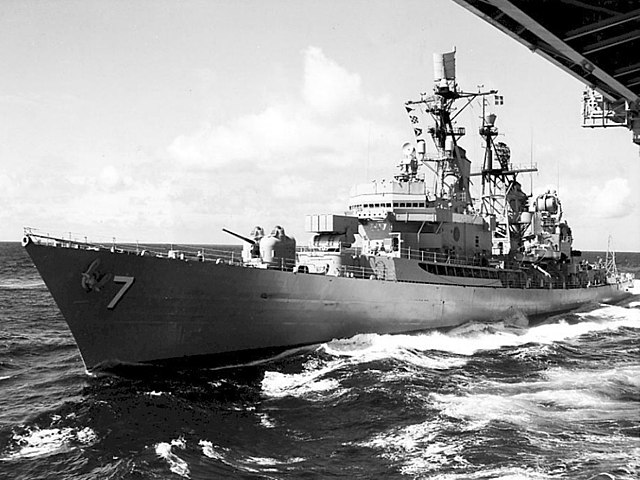
USS Luce after commissioning in 1962
USS Luce was commissioned on 20 May 1961 with Commander David H. Bagley in command and based in Mayport, Florida for her shakedown cruise (February 1962) and with the 6th Flee. She became flagship, Capt. H. J. Ereckson DesDiv 84 and on August was back to the 6th Fleet for NATO’s Riptide III with British and French ships. For 7 months this went on until back on 2 March 1963.
From August 1963 she trained in the Caribbean Sea and later joined Task Force 23 for ASW/AA exercises in October and teaming with USS Enterprise. By February 1964 she was back with the 6th Fleet, operating off Cyprus during the crissis and hosting the Secretary of the Navy and the Commander of the 6th Fleet on 24 April for a firing demonstration. She escorted USS Shangri-La back to Mayport in May.
In July she took part in operation “Sail” in NyC. She had a 4-month overhaul in January 1965 and won the Battle Efficiency “E” that year.
After Caribbean refresher training by March she was sent to the Dominican Republic on 30 April, patrolling the shore during a civil war. She was back in the Mediterranean in June, spending 4 months of operations joint NATO exercises. She entered the black sea with USS Corry and was back to Mayport on 6 November. As flagship, DesRon 8 by December she performed missile drills, interrupted on 19 January 1966 by an “actual nuclear incident” as the nuclear warhead on her Terrier separated and fell from eight feet on the deck while she was moored at Mayport NS.
On 13 June 1966 she returned to the 6th Fleet (Mediterranean) for exercises and showed the flag in two international trade fairs and back on 26 October. In 1967 the same routine went on between the Atlantic and Caribbean, plus a midshipmen training cruise in June 1967. By August she had her first long overhaul at Charleston until early 1968, then operated locally and in the Caribbean. On 14 September she departed for the Persian Gulf via Recife in Brazil and the coast of Africa to Bahrain on 29 October.
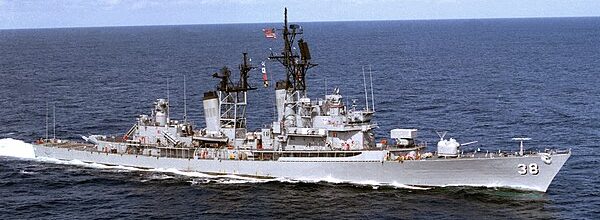
USS Luce, Mediterranean 12 March 1958
USS Luce went on to serve and operate in the Atlantic, Mediterrean, and Caribbean and by June 1975, she was reclassified as guided-missile destroyer DDG-38. She took part in the 1980s middle east crisis, between the Iranian hostage crisis, Lebanon, Libya, had a last overhaul, and USS Luce was eventually decommissioned on 1 April 1991 at Mayport in Florida, stricken on 20 November 1992, sold on 16 December 1994, and BU until 17 June 2005.
 USS MacDonough (DDG-39)
USS MacDonough (DDG-39)
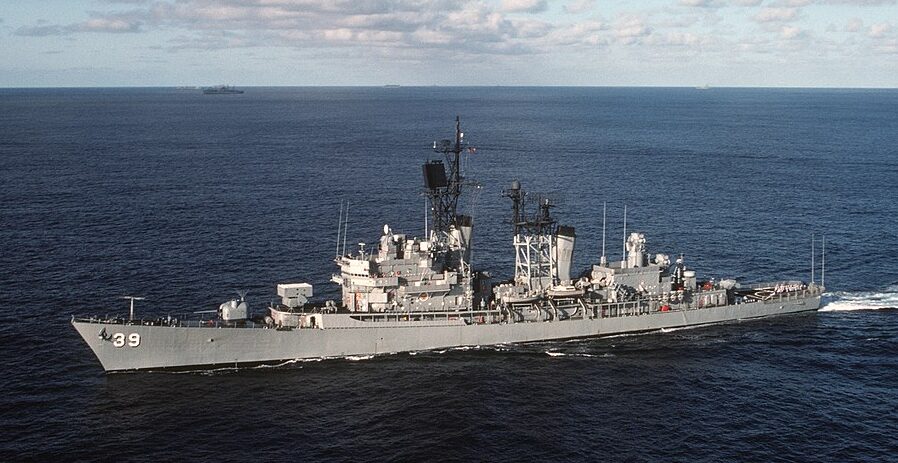
USS MacDonough was commissioned on 4 November 1961, and after shakedown and training was homeported to Charleston NS from 23 September 1962. She became flagship for the Cruiser-Destroyer Flotilla 6 of the Atlantic Fleet. She joined later the 2nd Fleet, enforcing the Cuban quarantine (Cuban Missile Crisis) and TG 136.1 (Rear Admiral John Ailes CruDesFlot 6) until dissolved on 22 November. In 1963 she trained firing missiles off Florida under the Operational Test and Evaluation Force. She made her first Mediterranean 6th Fleet deployment from 4 June.
She took part there to many NATO fleet exercises and training and was back to the East Coast on 26 October, enging off Charleston. Next she trained off Puerto Rico with the 2nd Fleet, in live-firing AAW exercise, firing on drones. She took part in carrier exercises off the East Coast and her first helicopter evaluation tests.
Next she made her second Mediterranean deployment from 10 July to 22 December 1964, and had a 6-month overhaul at Charleston. She trained until mid-September 1965, and joined the Atlantic Fleet Missile Range off Cuba, for more training. She was back to Charleston in early November and made another Mediterranean deployment. She was flagship after the Palomares Incident (third Mediterranean deployment).
On 8 April 1966 she was back to her routine of fleet and squadron exercises and making her midshipman training cruise, then AAW/ASW/Amphib. “LANTFLEX 66” exercise. On 2 May 1967, she departed Charleston for her 4th MedTod, made her summer midshipmen cruise in the Mediterranean and was back in October. She trained with the 2nd Fleet until May 1968 and her 5th MedTod in the Mediterranean, back in in September. She stayed on the east coast in 1969 (No more infos afterwards. Note: These informations came from original logs resumed by authors at history.navy.mil, sometimes later logs are unavailable or does not have been redacted yet).
She was reclassified as DDG-39 in 1975, presumably went through the same operation as her sisters in the Mediterranean and middle east, was overhauled, and decommissioned on 23 October 1992, stricken on 30 November 1992, sold for BU.
 USS Coontz (DDG-40)
USS Coontz (DDG-40)
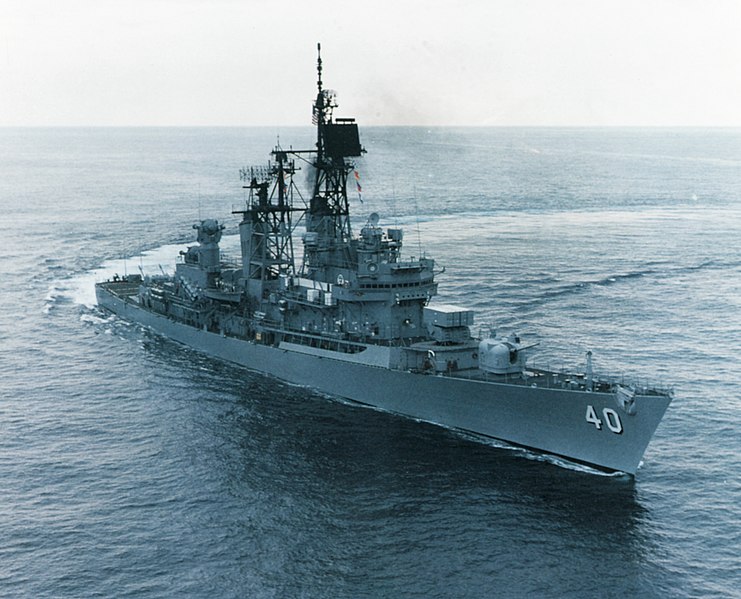
USS Coontz after completion (under command of Captain Reis) was assigned to the “Cruiser-Destroyer Force” of the U.S. Pacific Fleet. She joined the 1st Fleet as flagship, DesDiv 152, homeported in San Diego, California. DesDiv 15 CO flew his flag on USS Coontz from 4 May to 12 July 1961. She started her first overseas sortie on 10 August 1961 to join the 7th Fleet, fast carrier task force. She was here for seven months, covering 55,000 nm (102,000 km; 63,000 mi) and sopping in Japan, Korea, Hong Kong and Australia among others. She was rewarded by the excellence “E” award for missile skills.
Back home on 23 March 1962, 1st Fleet, flagship DesRon 17, April 1962. She earned a second “E” of Engineering and Gunnery and flew the flag of CruDes Flot. 11 until 11 November 1962, then DesRon 17 again. In October 1962 she covered Camp Pendleton Marine transports during the Cuban Missile Crisis.
Commander James R. Collier took command by July 1962 and she returned with the 7th Fleet, also acting as stand-by recovery ship for Mercury-Atlas 8, but not activated. Back home in May 1963. In June 1963, she made a Terrier demonstration for President John F. Kennedy. After which she was overhauled from October 1963 to April 1964 at the Long Beach Naval Shipyard.
First modernization

With Commander Eugene C. Kenyon, Jr. in command from March 1964 she was back with the Pacific Fleet in April 1964, after weapons systems qualification trials and refresher training, being awarded the Missile, Gunnery and engineering “E” award. On 3 August 1964 she was again flagship, DesRon 17. She joined the 7th Fleet on 16 August 1964 for six months, making 41,000 miles between the Philippines, Hong Kong and Japan. In December for the start of her Vietnam war career she earned the Armed Forces Expeditionary Medal. She was returned to the 1st fleet and went back home on 6 February 1965.
She took part in the summer midshipmen training cruise, receiving “E”, “C” and “A” awards (adding communications and ASW). On 14 August 1965, Commander W. Cummings took command and she was sent in December 1965 for another overhaul in San Diego. When completed in January 1966 she had an Helicopter Landing/Handling capability, relocated of deck vents fantail obstructions gone, JP-5 fuel tank plus handling/purification system and connection to start an Helicopter and power it. USS Coontz was the first to receive that upgrade.
She retrurned to Vietnam in January 1966, 7th Fleet and stayed there for six months, with stops in Japan and the Philippines, but also Kaohsiung, in Taiwan. In March 1966, she earned the Unit Commendation Ribbon. On 1st July 1966, three North Vietnamese YBs closed on USS Coontz and USS Rogers, while themseves were 55 miles (89 km) offshore in SAR. Carrier planes scrambled and destroyed them before they could e close enough to engage. Coontz picked up 19 North Vietnamese sailors.
After her return to 1st Fleet control, she was back home by August 1966, having a short overhaul at Long Beach. She was back for her 5th WESTPAC on 25 July 1967, Western Pacific, but on search-and-rescue (SAR) and CV cover or “special assignments” like shore bombardment. Commander E. Dale Geiger took command on 28 July, while en route. In August she visited Jakarta, Indonesia for the first time. She was soon back in the Tonkin Gulf, rescuing nine aviators. She returned to San Diego via Sydney and Wellington, Samoa and Pearl Harbor.
During her upkeep preiod in San Diego she received the new Test and Evaluation Monitoring System (TEAMS), the first USN automatic test system. After her usual summer midshipmen cruise she returned to the 1st Fleet operations and exercise Beat Cadence. On 15 November 1968 she returned for her 4th Vietnam Tour of duty, 6th WestPac.
She was assigned to Yankee Station and on 8 February 1969, Commander Donald P. Roane took command. After a stop in Hong Kong, she was back in the Gulf of Tonkin followed by upkeep at Yokosuka. She was in Sea of Japan for patrols and back to San Diego on 18 May.
In September 1969 after a short upkeep period she took part in “HUKASWEX” with the 1st fleet, followed by extensive upkeep, earning another E for Supply, Operations and ASW. She was at sea again on 3 March 1970 and on 8 July Commander T.J. Bowen took command. She made her 7th Westpac, and crossed the Panama Canal for her major overhaul and modernization in Philadelphia Naval Shipyard, decommissioned on 23 February 1971, recommissioned on 18 March 1972, homeported to Newport, Rhode Island with T.R.M.Emery in command since 8 March. After refrsher training and cruise for six-month in Guantánamo Bay she was sent for a “show the flag” cruise to South America and Africa. After her Boston post Shakedown Availability she was deployed on 6 July 1973 with the Mediterranean 6th Fleet under command of F.N. Howe from 20 December.
Back home in January 1974 she was homeported to Norfolk, Virginia. She returned to the 6th fleet on 15 November, taking part in many NATO exercises. She was redesignated DDG-40 the next year, on 1 July 1975. After upkeep home she departed on 17 January 1976 with STANAVFORLANT in the Caribbean and up to the Canadian waters with NATO fleets; She visited 8 countries and took part in many NATO exercises. Silas O. Nunn III took command on 6 March 1976, then W. P. Martin on 8 April 1978.
After a new overhaul at Norfolk she took part from 21 July 1978 to gunnery, missile and Harpoon system qualifications, plus a refresher cruise in Cub, then 6 months of local operations such as GULFEX 78 in November 1978, STANAVFORLANT as flagship in 1979, being the host of some 35,000 visitors in 8 NATO countries and going to the Arctic Circle, Baltic Sea, North Sea, Norwegian Sea. Commander C.P. Willoz took command on 28 September 1979.
On 14 July 1981, she had an accidental live Harpoon missile fire 60 nm (110 km) off St. Croix, but the missile apparently crashed at sea, as no debris was found. USS Coontz next cruised Western Africa and returned to the Mediterranean and visited the Black Sea and the Adriatic, stopping at Dubrovnik. Commander J.P. Reason took command on 6 September 1981. She went on in operations on the Eastern coast of Central America (mid-1982) and stopped in the Dutch Carribeans. Back in Philadelphia she was given a long overhaul with alterations and modernizations. Commander L.P. Brooks, Jr. took command on on 17 December 1982 and she was underway on July 1983.
Soon, she took part in Operation Urgent Fury, the Grenada Invasion:
In October 1983 she made weapons systems testing over three months in the Carribean while ordered to join Operation Urgent Fury, providing gunfire support for ten days during the amphibious assault and progression. She was was awarded the Armed Forces Expeditionary medal and Meritorious Unit Commendation.
In 1984, she had a new refresher training and fleet exercise and returned to the Mediterranean in October, this time operating off Beirut, Lebanon, and the Black Sea under Commander Charles H. Gnerlich from 25 February 1985. She was back home in May 1985. Until October she had her first “Phased Maintenance Availability” due to her age, alternating between more intensive operational availability instead of long overhauls. By November 1985, she took part in Operation Bold Eagle, a joint exercise in the Gulf of Mexico. Next was Ocean Venture ’86 with the Coast Guard and practicing Naval Gunfire at the Vieques Island Range (Puerto Rico).
In November 1986 she won the coveted “Battle Efficiency” Award, covering every department. Until early 1987, she was prepared to be deployed to the Persian Gulf under command of the Middle East Forces. She was to patrol and ensure good navigation in the Persian Gulf as the Iran–Iraq War rage on under command of Cdr. William W. Cobb, Jr. from April. Her teams helped to master fire on USS Stark after being hit by Iraqi Exocet missiles. She was back in Norfolk on 5 August 1987, entering a 3 month SRA and was reassigned to the 2nd.
Commander W.E. Cox took command 21 July 1989 to oversaw USS Coontz decommission at Philadelphia from 2 October. She was to be sold for BU in April 1994 but repossessed in October 1996, resold in February 1999 and dismantled, completed on 26 March 2003. The transom stern was saved by an association of veterans and is now in display in Nipper Park, Hannibal, Missouri (birthplace of Admiral Robert. E. Coontz);
 USS King (DDG-41)
USS King (DDG-41)
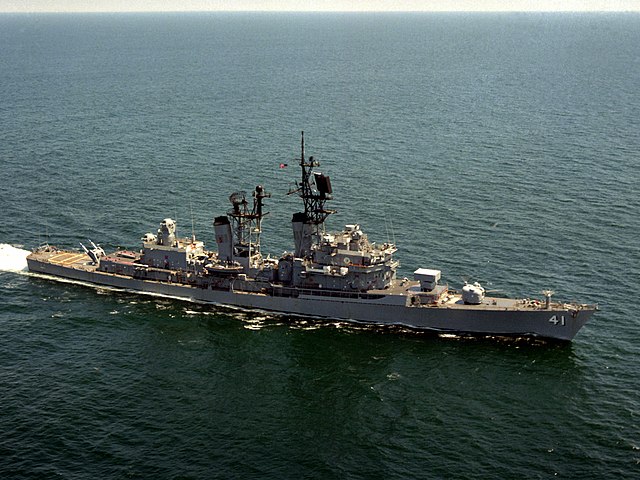
USS King after her sea trials and commission, undertook her shakedown cruise along the east coast, and via Panama, entered the Pacific and was in Hawaiian waters, homeported in San Diego in the fall of 1961. She departed for her first WestPac on 7 June 1962, with the 7th Fleet as part of the peacekeeping force as the situation degraded in Vietnam. Back in San Diego on 31 December she amde exerciezes off the West Coast until 1 August 1963, followed by her second WestPac, then back to San Diego on 10 March 1964.
She departed again for the Pacific on 5 April 1965 as an escort for USS Oriskany, operating in the South China Sea in May for air-sea rescue. She was back home on 2 November and back again in the Western Pacific 26 May 1966, this time modified as USS Coontz, with a new helicopter deck and permament helicopter for SAR missions during strikes against North Vietnam. She was provisionally homeported at Da Nang from 27 June. In August she was in PIRAZ duties (positive identification and radar advisory zone) in the Gulf of Tonkin, checking over 15,000 aircraft before departure and rescutin 7 pilots. Her supply runs were at Hong Kong and Subic Bay. She was replaced by USS Long Beach on 29 November.
The source is not clear about her records for late 1969 up to 1980. Data is missing. In 1975 she was declassified as DDG like the others.
By February 1980, she had three crew members lost at sea while underway in the the Atlantic 50 miles northeast of Cape Hatteras (snowstorm) with a fourth member washed overboard but rescued. She won in 1982 the Marjorie Sterrett Battleship Fund Award for her service and was eventually decommissioned on 28 March 1991, stricken on 20 November 1992 and sold on 15 April 1994, BU in 1995.
 USS Mahan (DDG-42)
USS Mahan (DDG-42)
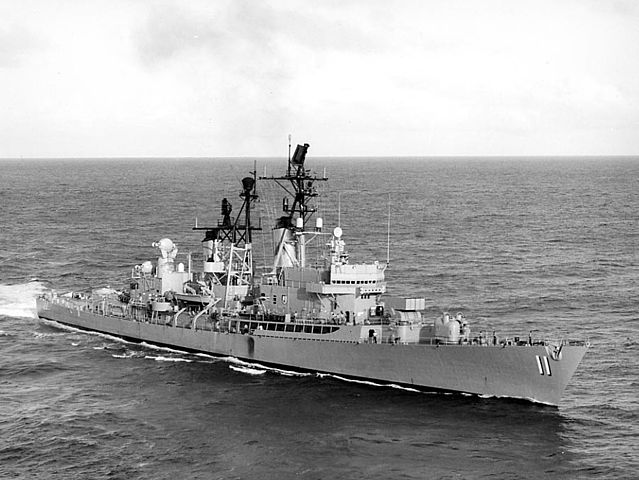
USS Mahan in 1963
USS Mahan was commissioned on 25 December 1960 and after her shakedown cruise started testing and evaluating her weapons systems. Homeported in San Diego, she took part in exercises on the west coast and at Pearl Harbor, and left San Diego on 6 June 1962 for her first WestPac. For 6 months with the 7th Fleet she took part in many exercises cut by good-will visits, like Saigon (24-28 October) the Independence anniversary celebrations. After her overhaul at Long Beach and new training exercises off the west coast she departed for her 2nd Westpac on 6 August 1963 also in the Jaoanese and Philippine waters and patrolling off South Vietnam.
She trained on west coast until late 1965 followed by a five months overhaul (1 May 1965-20 October 1965) and while back in exercizes, put the emphasis on ASW warfare with the RCAN and Canadian personal onboard on 9 December 1965. She mad her summer midshipmen cruise (plus NROTC personal) and departed on 19 October via Pearl Harbor the the 3rd WestPac (with for ASW training off Hawaii) homeported at Subic Bay on 22 November 1965. She patrol off Vietnam and was back to San Diego in April 1966. The same routine was repeated, but by August 1966 she received the same helideck as her sisters King and Coontz before returning to Vietnam from December 1966 to 4 June 1967. She was PIRAZ in the Gulf of Tonkin and detached for gunfire support. Back home on 17 June, she represented the Navy at Seattle’s annual Sea Fair. Back in Long Beach Naval on 1 November she was overhauled until April 1968. She made her next WestPac in 1969, 1970, 1972 and 1973 without notable event.
In 1973, she entered Bath Iron Works, Maine for her mid-life major overhaul until 1974. On 1 April 1975 while she was undergoing shakedown, new weapons systems trials, and post-shakedown availability, she was recommissioned at Bath, joined DesRon 4. Her new home port became Charleston and she became test platform for the CG/SM-2 (ER) missile program to replace the RIM-2 Terrier. This became the “standard SM” missile.
After a quick overhaul in Philadelphia until May 1981, she tested the Terrier New Threat Upgrade (NTU) Combat System comprising the RIM-67 Standard SAM Block II, tested in fact from October 1981 to March 1985. She was a prototype to modernize other ships in her class but this was cancelled as not cost-effective due to their age.
By April-November 1983 she returned to the Mediterranean Sea, taking part in a Multinational Peacekeeping Force off Beirut during the Lebanon civil war. In July 1985, she conducted the first USN Remote Track Launch on Search missile firing. In 1985 she was again in the Mediterranean, taking part in Exercise “Ocean Safari 85” with the French Navy. She was a Ready Ship off of Israel and was patrolling the Gulf of Sidra for the Freedom of Navigation operations off the Libyan coast. Back home in April 1986, she entered the drydock for a 10-month overhaul, ending in August 1987.
After refrsher cruise in January 1988, she took part in a joint missile exercise with the Bundesmarine. She was part of the “Standing Naval Forces Atlantic” from 17 June to 16 December 1989 and visited eight countries, and operated with nine NATO nations. By November 1989 she fired her first SM-2 Block II (ER) in Northern Europe.
Her last mission was Operation Desert Storm (26 September 1991-2 April 1992). She transited the Suez Canal on 13 October and stayed 5 months in the Persian Gulf until leaving the Mediterranean and sailing north, crossing the Arctic Circle and taking part in “Teamwork 92”. She was inactivated on 15 June 1993 at NS Charleston, decommissioned, stricken on 15 June 1993 sold on 31 August 1995 but repossessed, resold on 10 February 1999 and again in 10 July 2000 with a final displanting contract signed on January 2003 with Bethlehem Steel-Sparrows Point, Baltimore, but as it went out of business, on 30 September 2003 to Metro Machine, Philadelphia, BU completed on 18 May 2004.
 USS Dahlgren (DDG-43)
USS Dahlgren (DDG-43)
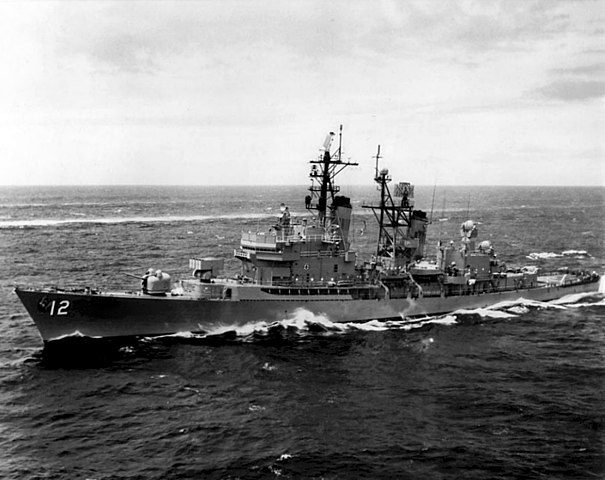
USS Dahlgren, named after the US admiral and inventor of a new gun using explosive shells, was commissioned on 8 April 1961, third of the name, as DLG-12 but reclassified a guided missile destroyer on July 1, 1975 (DDG-43). Little information has been published under her career records. However, she served in Vietnam and the Mediterranean and was distinguished several times:
She was awarded three Meritorious Unit Commendations on 8 March and 20 August 1967 but also 5 September 1969 for her service in Vietnam, as well as on 30 Jun 1970 and 5-18 October 1970. She won two Vietnam Battle Stars (10 April-17 May and 5 June-13 July 1967). She also earned two Navy Excellence “E” Ribbons on 1 July 1974 and 30 June 1975 as well as on 1 October 1989 and 31 December 1991. She earned Navy Expeditionary Medal for her actions during the Cuban blockade from 25 September to 27 October 1961, and three Armed Forces Expeditionary Medals for the action at Quemoy-Matsu on 27 October to 11 November 1962, and twi for her service in the Persian Gulf from 20 May to 30 July 1988 as well as for 1st March to 3 August 1990. She also earned a U.S. Coast Guard SOS Ribbon.
She was in active service until 1992, placed in reserve. USS Dahlgren was decommissioned on 31 July 1992. She was stricken on 20 November 1992, transferred to the James River Reserve Fleet on 1 July 1993. Sold for BU three times as other ships in the class, by twists of fate. The first time she was sold on 1994 to N.R. Acquisition, New York, on 15 April, but subcontracted to Wilmington Resources (later Sigma Recycling in 1996), which in between lost its permits to dismantle ships on 24 July 1996. Therefore she was repossessed by by the Navy again, and resold to International Shipbreakers (Brownsville, Texas), on 10 February 1999. But it failed to repossess the ship when scheduled and thus, the contract was broken and was repossessed again on 10 July 2000. A new contract was passed on 29 July 2005, to ESCO Marine of Brownsville, Texas and this time it went through full dismantling.
 USS William. D. Pratt (DDG-44)
USS William. D. Pratt (DDG-44)
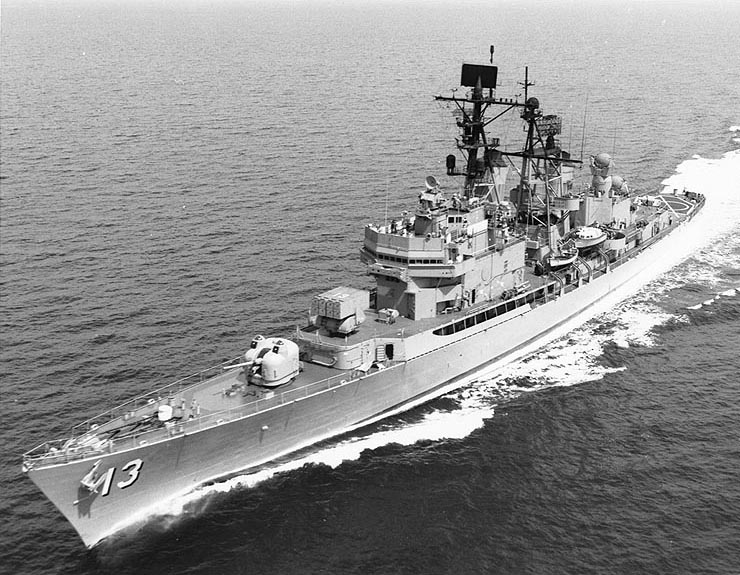
USS William V. Pratt in 1969, Mediterranean
USS William V. Pratt (after admiral Pratt, 28 February 1869 – 25 November 1957 also president of the naval war college) was commissioned on 4 November 1961. She performed her shakedown cruise and initial training in the West Indies, post-shakedown availability at Philadelphia. She was assigned when ready to DesRon 18 in September 1962. Homeported at Norfolk NS in Virginia, she stayed between the Atlantic and Carribean until 4 August 1963, joining afterwards NATO’s Operation Riptide IV in European waters.
Mediterranean Service
Back to to Norfolk in September she resumed service with the 2nd Fleet and this went on until 8 February 1964. She embarked upon her first tour of duty with the 6th Fleet, Mediterranean. Back on Norfolk on 9 August and resumed her East Coast to West Indies routine. September-October saw her back in European waters, participating in NATO Operations Masterstroke and Teamwork. Back to Norfolk on 20 October, same routine with the 2nd Fleet. In November she had her first shipyard overhaul, at Norfolk. On 26 March 1966 she started her post-overhaul trials.
On 15 April she was based Naval Station Mayport in Florida. After a refresher training in Cuban waters (May-June) she was back to Mayport on 3 July. East Coast operations until 27 August and her second Med Tod for four-months, until 17 December. For the next six months USS William V. Pratt stayed at Mayport and the West Indies, or the Gulf of Mexico and Virginia Capes. In July 1966, she made her 3rd Med Tod, 6th Fleet for five months and was in Mayport by 20 December.
Vietnam Service
After six months of rotine east coast/Carib training in 1967 she departed on 20 June for her only deployment in the western Pacific and Vietnam War tour of duty. After her Panama Canal crossing she stopped in San Diego, Pearl Harbor, Midway, and Guam, homeported to Subic Bay, Philippines (28 July). In August she was in the Gulf of Tonkin on her SAR station, relieving USS Berkeley on the 12th and staying until September. She had an upkeep in Subic Bay and and was reassigned to the south SAR station until late November. After a stop at Kaohsiung she reached Taiwan and returned to the south SAR station. She left via Yokosuka, Midway and Pearl Harbor for home, San Diego, on 31 December. On 2 January 1968, she was underway to Mayport via the Panama Canal, arriving on 16 January. Pratt earned one battle star during hr short tour in Vietnam.
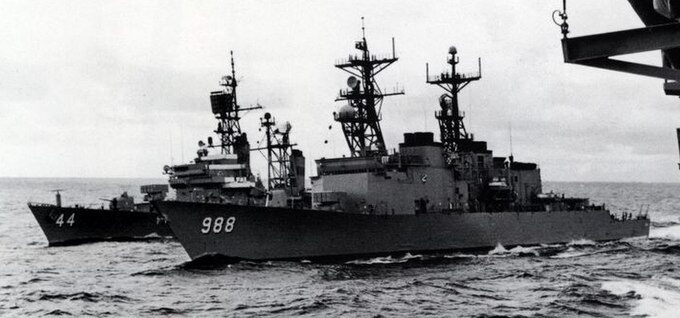
Old and New: USS Thorn, a Spruance class freshly commissioned, and USS William Pratt in the Atlantic, 1981
Back to 2nd/6th fleet service
In February 1968, she had a regular overhaul at Charleston and on 1st March for a six-month upkeep, leaving on 6 September to Mayport and after her refresher training she resumed service with the 2nd and 6th Fleet (4th Med Tod). The same repeated in 1969. She left Mayport on 7 January 1969 for a 5th Med Tod on the 18th, five months, while back on 1 June she was Rota for turnover ceremonies and took part in hunter/killer exercises also visiting northern European ports. She was in portsmouth, departing on 7 July for home, arriving on the 15th, 2nd Fleet operations. She was there until 30 April and her 6th Med Tod. This time she was present for the Syrian intervention in the Jordanian civil war, patrolling the Levantine coast (September-October) until the Syrian withdrawal. She left on 1 November via Barcelona.
In 1970-1971 USS William V. Pratt repeated the same routine, but in 1971 instead of a 8th Med Tod, toured northern European waters, for hunter/killer exercises. On 29 October her main propulsion plant was modified to use Navy distillate fuel and was also overhauled to avoid the issues of some ships in her class. When completed on 17 January 1972 and routine exercises she departed on 18 February for her 8th Med Tod with the 6th Fleet. On 28 June she was in Rota, before reaching Mayport on 8 July. She was prepared for decommissioning before her major modernization overhaul at Philadelphia Naval Shipyard.
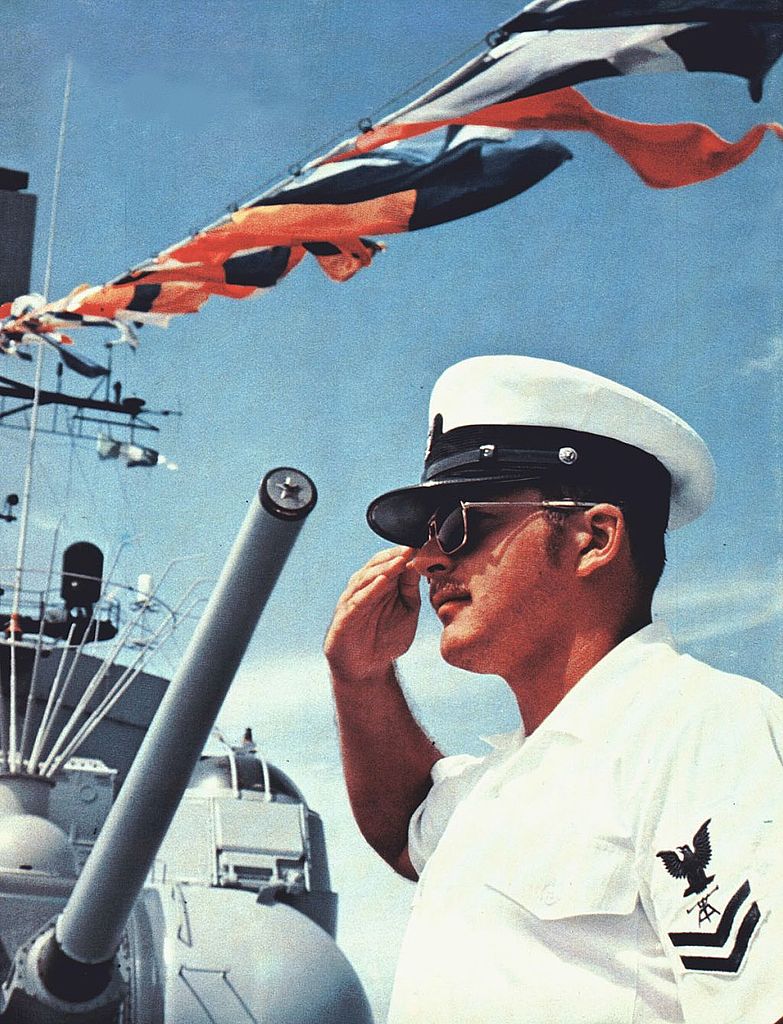
USS William V. Pratt was recommissioned at Philadelphia on 6 October 1973 (Cdr. Rodney B. McDaniel). She departed on the 23rd for her post-overhaul shakedown and trials, homeported to Charleston and arriving the 26th. Trials went on in December and she joined the 2nd Fleet in 1974, until 23 September, departing for a 9th Med Tod. Her provisional 6th fleet homeport was again Rota in Spain. During her mission she screened the Forrestal class carrier USS Independence and for five months trained with her and her sister USS Saratoga. On 8 March 1975 she was back in Rota and headed for Charleston. After leave and upkeep she was back in her 2nd Fleet routine operations, notably a NROTC midshipman cruise (May 1975) and on 1 July she was reclassified as DDG-44.
On 14 August, she left Charleston for multinational exercises UNITAS XVI with Latin America, until the end of 1975. On 8 December she was back in Charleston and prepared for restricted availability to enter the Naval Shipyard on 15 December, in overhaul until 29 March 1976. Back to Charleston on 7 April, 2nd Fleet, she took part in between to the International Naval Review in New York for Independence Day and resumed service into the summer of 1976. On 4 October she departed her home port with USS Jesse L. Brown, USS Julius A. Furer, and USS Valdez to join the 6th Fleet via Rota (14 October), screeing the Midway class USS Franklin D. Roosevelt, visited ports, conducted multinational NATO exercises until April 1977.
Back in Charleston on 21 April she had a 10-week availability in drydock, and on 8 July resumed her 2nd Fleet routine exercises, to the end of 1977 and 1978. On 11 July she made her 2nd South American waters ToD and UNITAS XIX, crowned by a circumnavigation and west coast exercizes. She was back to Charleston via the same cape, on 3 December.
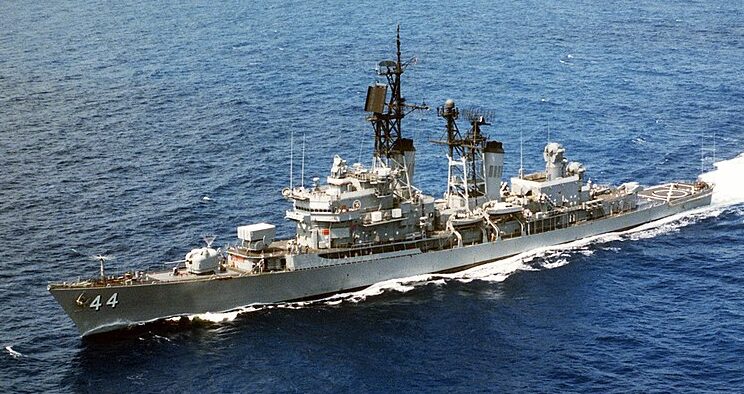
Pratt in 1987
In 1978-79 she made another deployment in the Mediterranean and UNITAS cruise in South American waters, making a full tour of South America via Panama. She had combat systems updates in 1980, made anither 6th Fleet tour in 1980 and Northern European waters tour in 1981. She was in the Med in 1982, participating in the Lebanon Crisis, providing gunfire support for U.S. Marines at Beirut. She also escorted Yassar Arafat from Lebanon to Piraeus. Her next years were all centered in the Mediterranean, but with a deployment in the Indian Ocean and Red Sea in 1984. She did no left the Mediterranean in 1987 and 1989. Her 1989 6th Fleet ToD saw major exercises off Norway and North Sea, English Channel before her upkeep in Charleston.
In 1990, she was deployed with the U.S. Coast Guard as “drug patrol” in the Caribbean. In 1991 she took part in the Gulf War and back home, she was decommissioned on 30 September 1991, stricken on 20 November 1992 and sold for on 14 September 1995 to Transforma Marine of Brownsville in Texas, dismantled.
 USS Dewey (DDG-45)
USS Dewey (DDG-45)
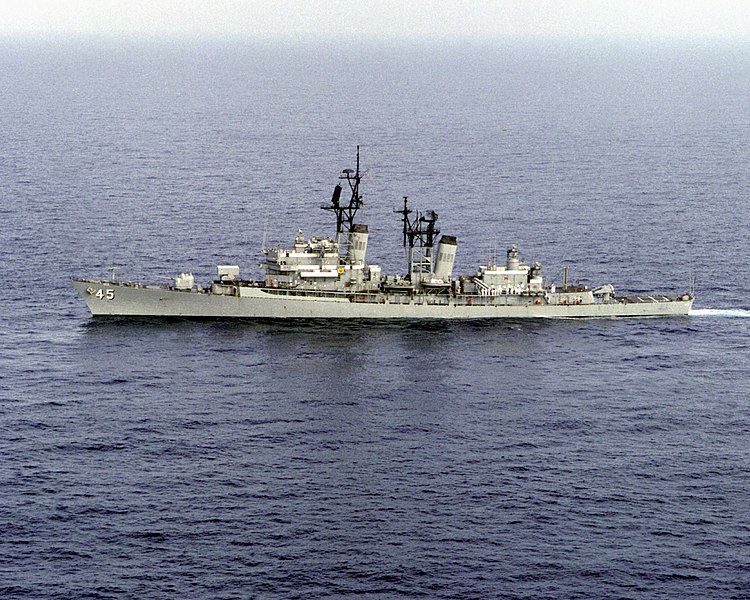
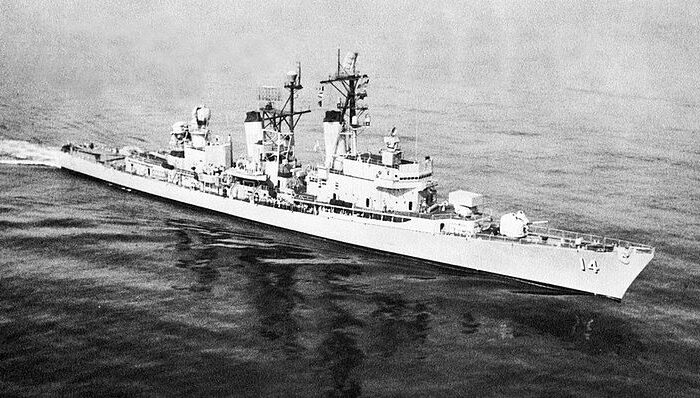
USS Dewey was commissioned on 7 December 1959 (with no less than Cdr Elmo R. Zumwalt, Jr. in command). Zumwalt in 1970 became the youngest Chief of Naval Operations ever in the USN. A brillant career which earned him posterity in the largest, costiest destroyer class ever in history. After her shakedown cruise in Cuban waters and initial sensors and weapons testings, USS Dewey (after the 1898 war admiral) spent sixth months training operations along the New England coast and Virginia Capes, prepared for the Atlantic Fleet. After post-shakedown overhaul and trials on 31 March 1971 she resumed her service, alternating between the Mediterranean and Atlantic. On 30 June 1975 she became DDG-45. Note; Precise career records are no yet registered. I hope this will be done in the future.
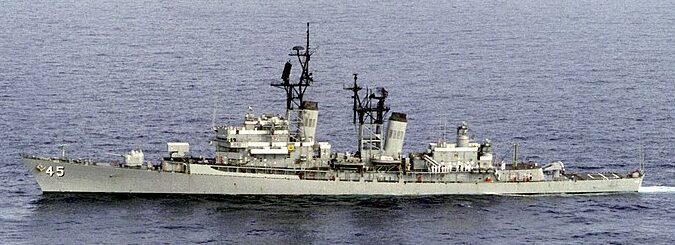
USS Dewey at sea on 17 October 1987. She was decommissioned on 31 August 1990 (missing the gulf war), stricken in 20 November 1992 and sold to J&L Metals, Wilmington on 15 April 1994, and scrapped in 1995.
 USS Preble (DDG-46)
USS Preble (DDG-46)
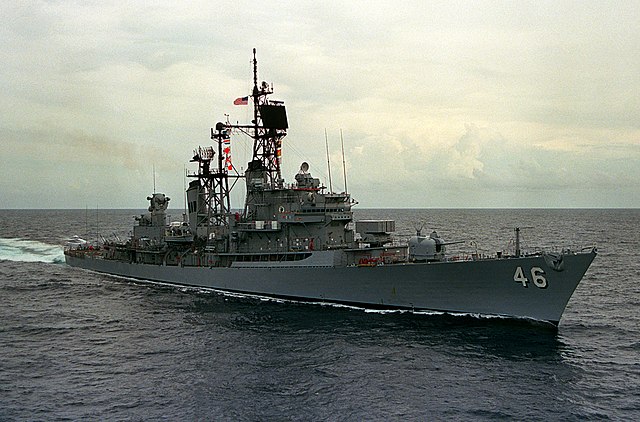
USS Preble was commissioned at Boston on 9 May 1960 and made her shakedown off the eastern coast, but transited Panama for San Diego, her new home port. Unlike her sisters she would be assigned the pacific fleet. On 2 September 1960 she started a serie of exercises on the west coast and departed for Pearl Harbor on 27 February 1961 for her first six-month WestPac, 7th Fleet. She was back in San Diego on 28 September, and 1st Fleet (West Coast) assignment for the next months and in 1963. From 26 February 1964 she departed for her second WestPac (13 March-20 July). This rotation between the 1st and 7th fleet went on for the next five years, and she was in action on the coast of Vietnam also, as plane guard for aircraft carriers in the Tonkin Gulf. She alternated this wartime service with SAR patrols and being detached for shore bombardments on the coast of North Vietnam. On 19 June 1968 (it seems she had received the same read deck modification as her vietnam sisters) she hosted Squadron 7 helicopter (Navy Lt.jg. Clyde Everett Lassen and crew) for advanced SAR notably a hazardous mission deep into North Vietnam for U.S. Navy pilots, later being awarded a Medal of Honor.
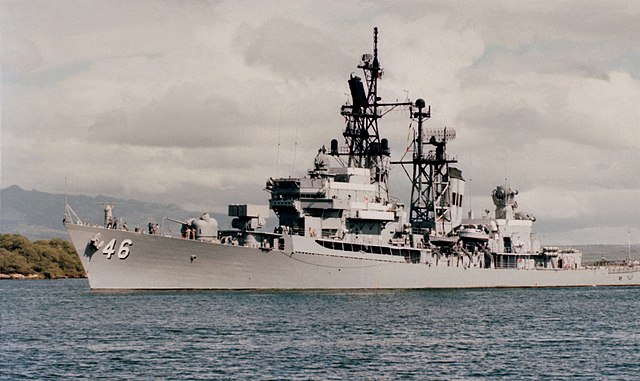
Back home in July 1968, she was in exercizes along the west coast and by December entered Philadelphia Naval Shipyard for her most extensive overhaul, decommissioned on 31 January 1969, recommissioned 23 May 1970. Her routine 1st/7th fleet resumed in 1971-1972. On 24 January 1973, while deployed with the 7th Fleet, detached in a bombardment mission, she was straddled by North Vietnamese long range artillery. She was hit off Quảng Trị Province (close to the DMZ) by a few shells and shrapnel, damaging her torpedo tubes and three antennae.
1974-1986 were spent in the same manner, with deployments with the 7th fleet, but nothing to report. After 1973 the war was seemingly over in Vietnam. Tensions however were still palpable in the region, notably the Sino-Vietnamese war and civil war in Cambodia.
In June 1987, USS Preble was attached to the Saratoga Battle Group, assigned to the Mediterranean Sea and making ehr first foray into the Black Sea. She was back in November 1987, being awarded DESRON 2’s Battle Efficiency “E” by March 1988 (Engineering, Damage Control, ASW, Electronic Warfare, Seamanship, Navigation, and Communications, the full monty, most coveted title in peacetime).
On 14 January 1989, USS Preble left her new homeport of Norfolk in Virginia to be deployed at the Standing Naval Force, Atlantic, operating with NATO fleets in the Northern Atlantic. She was backj to Norfolk on 14 July 1989.
USS Preble returned in the Med for Operation Desert Shield and following Desert Storm in 1990. She was part of the fleet deployed in the red sea. Back home, she was decommissioned for good on 15 November 1991, stricken on 20 November 1992, and sent to the James River Reserve Fleet (30 June 1993). She was sold to J&L Metals, Wilmington (15 April 1994), but repossessed, resold on 10 February 1999 (International Shipbreakers, Brownsville), repossessed again, 10 July 2000 and sold on 20 March 2002 to Metro Machine of Philadelphia, fully dismantled on 10 February 2003.
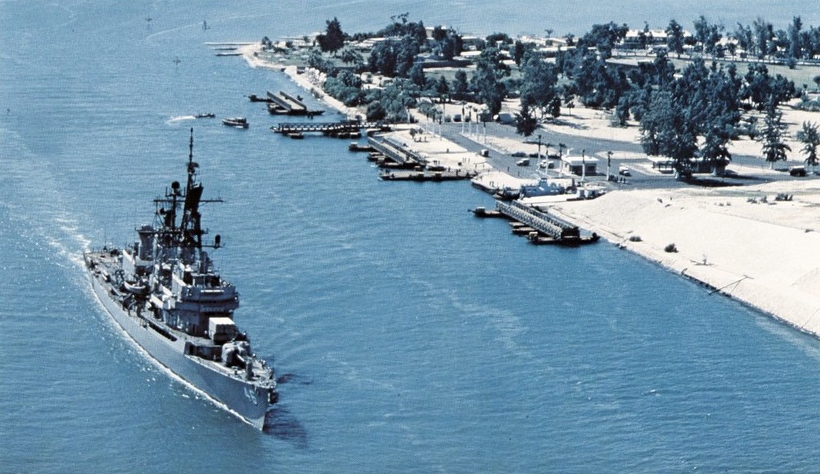
Read More
Books
Blackman, Raymond V. B. Jane’s Fighting Ships (1970/71) p.432
Polmar, Norman “The U.S. Navy: Shipboard Radars” United States Naval Institute Proceedings December 1978
Polmar, Norman “The U.S. Navy: Sonars, Part 1” United States Naval Institute Proceedings July 1981
Gardiner, Chumley & Budzbon, p. 580 – Conway’s all the world’s fighting ships 1947-1995
Friedman, Norman (1982). U.S. Destroyers: An Illustrated Design History. Annapolis, Maryland: Naval Institute Press. ISBN 0-87021-733-X.
Links
seaforces.org/
on destroyerhistory.org
on navysite.de/
on worldnavalships.com
on navymodeling.com/
on shipbucket.com
on man.fas.org/
on wikipedia.org/
on navsource.org/
on navypedia.org
Model Kits
 The old 1:500 renwal kit, conteporary of the ship
The old 1:500 renwal kit, conteporary of the ship
USS King DDG-51 1:350 by Iron shipwrights
1:96 USS Coontz model at the Scale Shipyward
Niko Model USS Coontz 1:700 (scalemates)
Very large USS Coontz model by modelmakers. They are official providers of the USN, their models are present in the naval academy, the pentagon, and many bases offices.
More on scalemates



 Latest Facebook Entry -
Latest Facebook Entry -  X(Tweeter) Naval Encyclopedia's deck archive
X(Tweeter) Naval Encyclopedia's deck archive Instagram (@navalencyc)
Instagram (@navalencyc)





 French Navy
French Navy Royal Navy
Royal Navy Russian Navy
Russian Navy Armada Espanola
Armada Espanola Austrian Navy
Austrian Navy K.u.K. Kriegsmarine
K.u.K. Kriegsmarine Dansk Marine
Dansk Marine Nautiko Hellenon
Nautiko Hellenon Koninklije Marine 1870
Koninklije Marine 1870 Marinha do Brasil
Marinha do Brasil Osmanlı Donanması
Osmanlı Donanması Marina Do Peru
Marina Do Peru Marinha do Portugal
Marinha do Portugal Regia Marina 1870
Regia Marina 1870 Nihhon Kaigun 1870
Nihhon Kaigun 1870 Preußische Marine 1870
Preußische Marine 1870 Russkiy Flot 1870
Russkiy Flot 1870 Svenska marinen
Svenska marinen Søværnet
Søværnet Union Navy
Union Navy Confederate Navy
Confederate Navy Armada de Argentina
Armada de Argentina Imperial Chinese Navy
Imperial Chinese Navy Marinha do Portugal
Marinha do Portugal Mexico
Mexico Kaiserliche Marine
Kaiserliche Marine 1898 US Navy
1898 US Navy Sovietskiy Flot
Sovietskiy Flot Royal Canadian Navy
Royal Canadian Navy Royal Australian Navy
Royal Australian Navy RNZN Fleet
RNZN Fleet Chinese Navy 1937
Chinese Navy 1937 Kriegsmarine
Kriegsmarine Chilean Navy
Chilean Navy Danish Navy
Danish Navy Finnish Navy
Finnish Navy Hellenic Navy
Hellenic Navy Polish Navy
Polish Navy Romanian Navy
Romanian Navy Turkish Navy
Turkish Navy Royal Yugoslav Navy
Royal Yugoslav Navy Royal Thai Navy
Royal Thai Navy Minor Navies
Minor Navies Albania
Albania Austria
Austria Belgium
Belgium Columbia
Columbia Costa Rica
Costa Rica Cuba
Cuba Czechoslovakia
Czechoslovakia Dominican Republic
Dominican Republic Haiti
Haiti Hungary
Hungary Honduras
Honduras Estonia
Estonia Iceland
Iceland Eire
Eire Equador
Equador Iran
Iran Iraq
Iraq Latvia
Latvia Liberia
Liberia Lithuania
Lithuania Mandchukuo
Mandchukuo Morocco
Morocco Nicaragua
Nicaragua Persia
Persia San Salvador
San Salvador Sarawak
Sarawak Uruguay
Uruguay Venezuela
Venezuela Zanzibar
Zanzibar Warsaw Pact Navies
Warsaw Pact Navies Bulgaria
Bulgaria Hungary
Hungary

 Bundesmarine
Bundesmarine Dutch Navy
Dutch Navy Hellenic Navy
Hellenic Navy Marina Militare
Marina Militare Yugoslav Navy
Yugoslav Navy Chinese Navy
Chinese Navy Indian Navy
Indian Navy Indonesian Navy
Indonesian Navy JMSDF
JMSDF North Korean Navy
North Korean Navy Pakistani Navy
Pakistani Navy Philippines Navy
Philippines Navy ROKN
ROKN Rep. of Singapore Navy
Rep. of Singapore Navy Taiwanese Navy
Taiwanese Navy IDF Navy
IDF Navy Saudi Navy
Saudi Navy Royal New Zealand Navy
Royal New Zealand Navy Egyptian Navy
Egyptian Navy South African Navy
South African Navy






























 Ukrainian Navy
Ukrainian Navy dbodesign
dbodesign
Para 1: …as well as anti-ship torpedoes inspired by memory. of the battle of Samar …
I do not believe their should be a period there.
Hello SuperkittyKatt Same here, it’s a starter article, more an introduction based on 20 years old infos, it needs both proper writing and proofchecking. But thanks for spotting thse oddities.